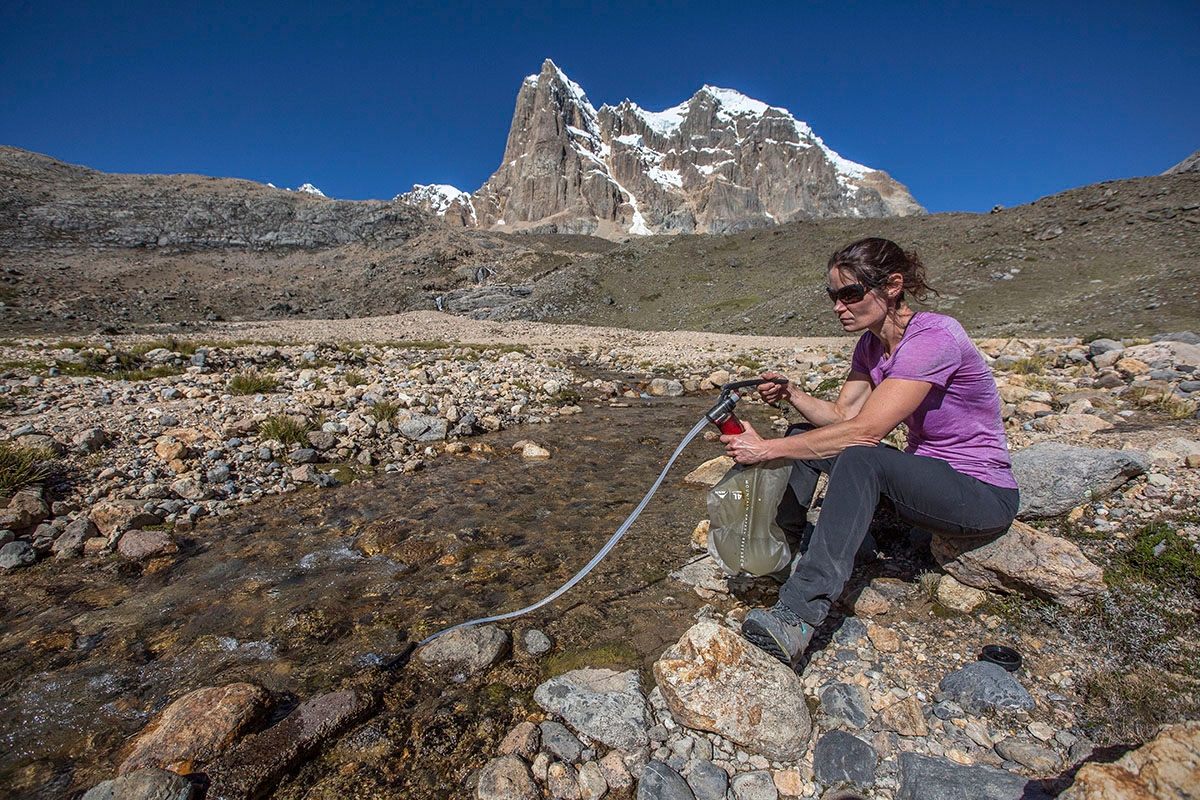
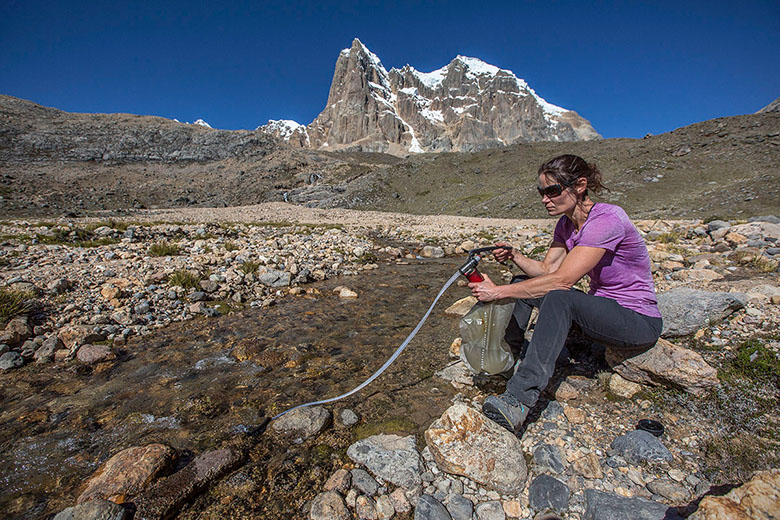
Switchback Travel (Brian McCurdy)
Everyone exploring the backcountry needs water, but staying hydrated is not as simple as drinking straight from streams and lakes. To protect against protozoa, bacteria, and even viruses, there is a wide range of water filtration and purification systems built specifically for backpacking (many options on this list are great for day hiking, trail running, and travel too). Our picks for the top backpacking water filters of 2024 include everything from ultralight squeeze filters and chemical drops to pumps and large-quantity gravity filters. For more background information, see our backpacking water filter comparison table and buying advice below the picks.
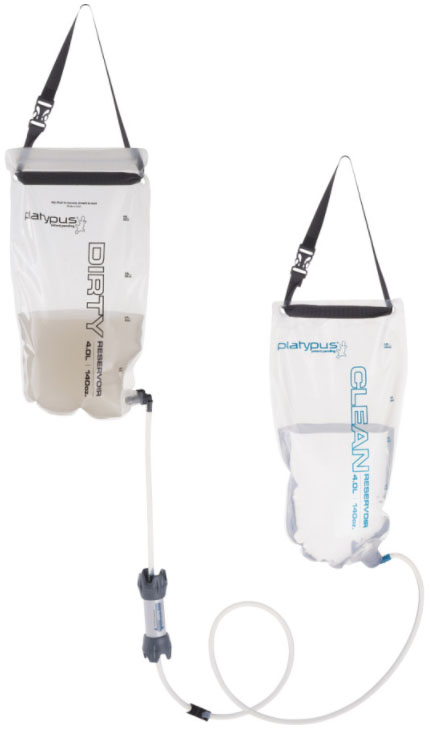 Type: Gravity filter
Type: Gravity filter
Weight: 11.5 oz.
Filter life: 1,500 liters
What we like: Filters and stores a high quantity of water effortlessly and quickly; great for groups.
What we don’t: Bulky; you need a decent water source to fill the bag.
Without a doubt, the Platypus GravityWorks is one of the most convenient water filters on the market, and it’s become a backpacking staple. Instead of pumping, this system requires minimal effort, can filter up to four liters of water at once, and boasts a speedy flow rate of 1.75 liters per minute. Gravity does all the work: simply fill up the 4-liter “dirty” reservoir, hang it from a tree branch or boulder, and in just a few minutes you’ll have four liters of clean water to drink. This filter is great for large groups, but we’ve enjoyed it on smaller outings too when we could quickly retrieve our day’s water and escape back to our camp to fill individual bottles (the clean bag also functions as water storage).
But compared to some of the more minimalist options below, the Platypus GravityWorks is not a small apparatus, with two bags, a filter, and a bundle of tubing. Furthermore, water retrieval can be a pain if you don’t have a reasonably deep or moving water source (similar to any system that relies on a bag to collect water). And at $135, the GravityWorks is on the more expensive end of the water filtration spectrum. But we love the convenience, especially for groups of backpackers or basecamp-type situations, and feel it’s worth the cost and bulk then. Keep in mind that you can also save a little with the GravityWorks Bottle Kit, a 2-liter system that filters water directly into your bottle or reservoir ($116, 9.1 oz.)... Read in-depth review
See the Platypus GravityWorks 4L
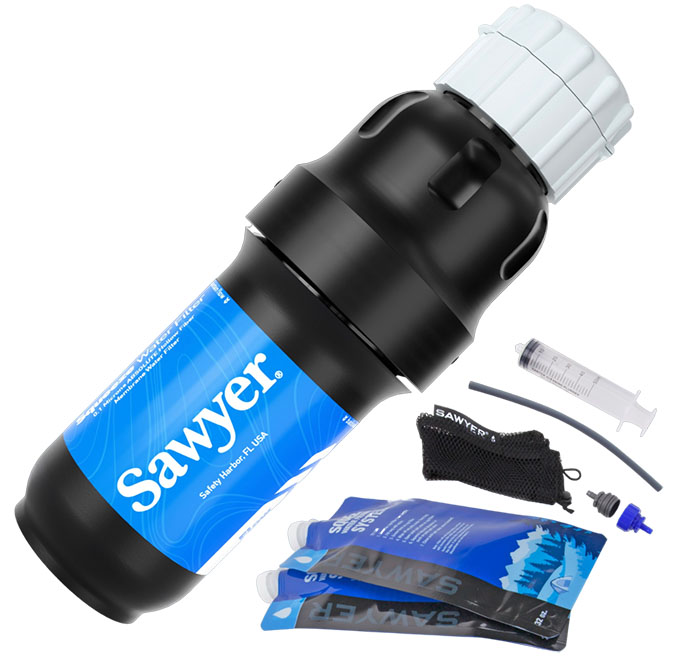 Type: Squeeze/inline filter
Type: Squeeze/inline filter
Weight: 3 oz.
Filter life: Lifetime
What we like: Super lightweight, fast flow rate, long-lasting.
What we don’t: You’ll have to buy extra gear to optimize your setup.
The Sawyer Squeeze epitomizes ultralight water treatment and has been a mainstay on the thru-hiking scene for years. It has a number of things going for it, including a streamlined 3-ounce build, lifetime warranty (Sawyer doesn’t even make replacement cartridges), and very reasonable price tag. It’s also extremely versatile: In its simplest application, you fill one of the two included 32-ounce pouches with dirty water and squeeze into a clean bottle or reservoir, a pot for cooking, or straight into your mouth. Sawyer also includes adapters so you can use the Squeeze as an inline filter on your hydration bladder or in a gravity setup (great for groups and basecamping) with additional bottles or reservoirs.
The Sawyer Squeeze has seen no shortage of competition in recent years, particularly from offerings like the LifeStraw Peak Squeeze, Katadyn BeFree, and Platypus Quickdraw below. These designs address our main concern with the Sawyer: the pouches. Not only do the Sawyer’s included pouches feature flat and handle-less designs that make water collection challenging, but they also suffer from serious durability issues (we recommend using a Smartwater bottle or longer-lasting Evernew or CNOC reservoir instead). But despite our gripes, no other filter comes close to matching the Squeeze’s versatility and longevity, which are undeniable draws for those who want to get a lot out of their gear. And if you prefer to go even lighter, Sawyer also offers “Mini” and “Micro” versions, although both have painfully slow flow rates that aren’t worth the 1-ounce (or less) weight savings.
See the Sawyer Squeeze Water Filter
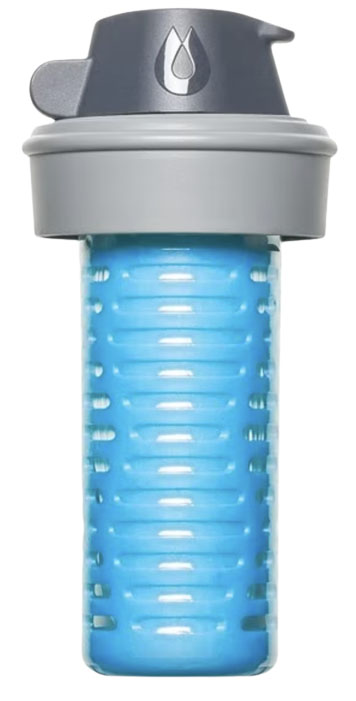 Type: Squeeze filter
Type: Squeeze filter
Weight: 2.0 oz.
Filter life: 1,500 liters
What we like: A premium filter that fits standard soft flask openings.
What we don’t: Doesn’t come with a vessel—check out HydraPak’s Flux and Seeker if you need a soft flask, too.
HydraPak’s new 42mm Filter Cap is the most recent in a long line of innovative squeeze filters, joining the likes of the Katadyn BeFree, Platypus QuickDraw, and LifeStraw Peak Squeeze below. Throughout the past four summers, we’ve tested each of these in succession, and the HydraPak is far and away the most impressive offering yet. Available on its own for $35, the HydraPak threads onto any 42-millimeter bottle opening (such as the soft flasks included in running vests from Salomon, Patagonia, Arc’teryx, and more) and filters water at a rate of over a liter per minute. We’ve found the HydraPak to be much easier to clean than the QuickDraw and Peak Squeeze, and it has a longer filter life (1,500 vs. 1,000L) than the BeFree.
The BeFree used to be the runaway favorite in this category, but for us, the HydraPak has swiftly overtaken it. One of the primary differences between the two filters is the nozzle design: The Flux’s cap is significantly more refined, with a solid twist and pop opening that does a great job protecting the hollow fibers inside. By contrast, the BeFree’s cheap-feeling nozzle is reminiscent of a disposable plastic water bottle, and the cap is easy to pry off if you’re not careful. We’ve also found that the HydraPak’s flow rate remains fairly constant over time, while our BeFree has slowed despite frequent maintenance. Most runners already have a soft flask or two, but if you want to purchase HydraPak’s filter with a vessel, check out the Flux+ 1.5L and Seeker+ 3L ($55 and $60 respectively).
See the HydraPak 42mm Filter Cap
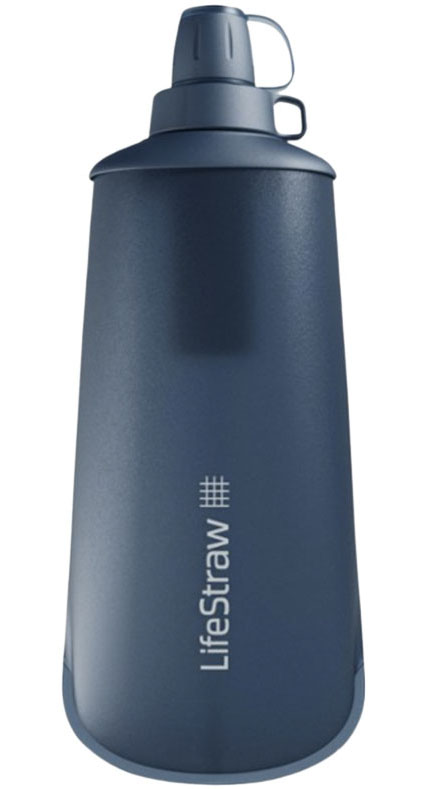
Type: Squeeze/gravity filter
Weight: 3.9 oz.
Filter life: 2,000 liters
What we like: An easy all-in-one squeeze filter and bottle for personal use; more durable than the competition.
What we don’t: Lower flow rate than the HydraPak Filter Cap; heavier and less versatile than the Sawyer Squeeze.
For hikers looking for a simple solution, an all-in-one squeeze filter and bottle is one of the best water treatment options. The Peak Squeeze here includes a squeeze filter similar to the HydraPak Filter Cap above, but bundles all you need into one easy package by tacking on a compatible soft flask, too. The setup excels as a handheld on trail runs and hikes when water is readily available, and can also be used to transfer clean water to a pot once in camp. Compared to standard running flasks from HydraPak (including the flask included with the BeFree below), it's noticeably durable, and the filter is decently versatile, too—like the Sawyer Squeeze, it threads onto bottles with standard-sized mouths and can also be used as a gravity filter, although you’ll have to purchase the tubing and “dirty” reservoir separately.
In parsing out the differences between the LifeStraw and its competitors, the Peak Squeeze does fall short in a few ways. For starters, it’s bulkier and heavier than pairing the HydraPak Filter Cap with a running flask (or the Katadyn BeFree), and requires a syringe (included) for proper cleaning. And unlike the Sawyer Squeeze, it only has a tube port on one end, meaning it can’t double as an inline filter with a hydration reservoir. Finally, despite its fast listed flow rate, we’ve found that the Peak Squeeze gets clogged fairly easily. But the price is right at just $44 for the 1-liter model (the 650mL bottle is $38), and it’s hard to beat the simple convenience of the design, especially compared to the Sawyer. All told, we’re more likely to recommend the Peak Squeeze for simple solo use than any other filter setup.
See the LifeStraw Peak Squeeze 1L
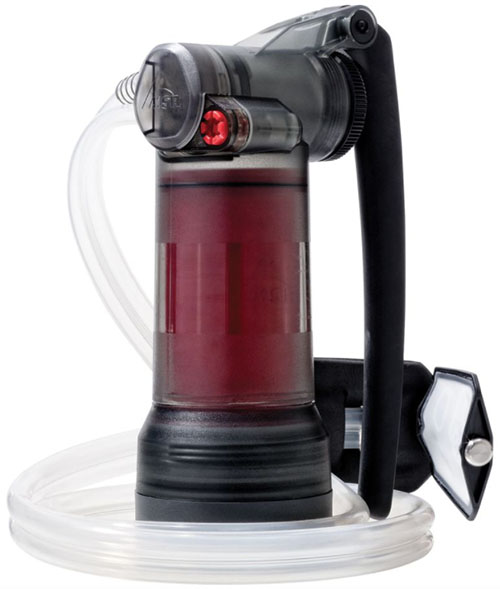 Type: Pump filter/purifier
Type: Pump filter/purifier
Weight: 1 lb. 1.3 oz.
Filter life: 10,000 liters
What we like: The most advanced portable water purifier on the market.
What we don’t: At $390, the Guardian is the priciest option on this list.
The MSR Guardian is ten times the price of many popular squeeze filters here, but this pump is the real deal. Most importantly, it’s both a water filter and purifier, which means you get the highest level of protection against protozoa, bacteria, and viruses, along with a filter that removes debris. Further, the Guardian uses advanced self-cleaning technology (about 10% of water from each pump cycle is used to clean the filter) and is far less likely to break down than cheaper models. And finally, with a 2.5 liter-per-minute flow rate, the MSR is ridiculously speedy. The result is ultimate performance and peace of mind when backpacking and traveling in less-developed regions of the world or other high-use areas (viruses are most commonly carried in human waste). In fact, the Guardian is such a reliable and convenient system that it’s also used in the military and as an emergency water purifier after natural disasters.
You won’t find a faster or more reliable pump filter/purifier, but the MSR Guardian will be overkill for many. Aside from cost, it’s noticeably heavier and bulkier than most filters at just over a pound and packing down roughly to the size of a 1-liter water bottle. Further, while the purifying capabilities are smart for traveling and backpacking in certain regions of the world, they’re not necessary in most wilderness areas in the United States and Canada. Nevertheless, the Guardian truly is the ultimate backpacking purifier and worth the cost for those who need it. And MSR also makes the Guardian Gravity Purifier ($300), which features the same advanced technology of the Guardian but in a gravity setup... Read in-depth review
See the MSR Guardian Purifier System
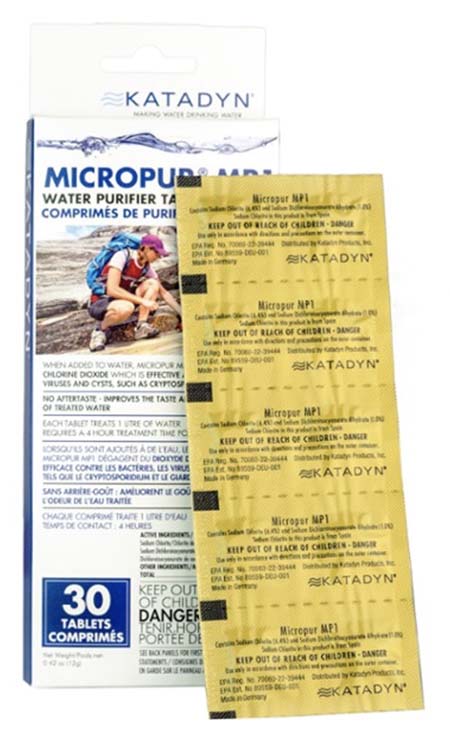 Type: Chemical purifier
Type: Chemical purifier
Weight: 0.9 oz.
Treatment ratio: 1L per tablet
What we like: Simple and light.
What we don’t: More expensive than Aquamira and you’re drinking unfiltered water straight from the source.
Similar to Aquamira drops below, Katadyn Micropur tablets are a simple and effective chemical treatment using chlorine dioxide. For backpackers, there is a strong argument for going this route: The tablets weigh less than 1 ounce for 30, making them by far the lightest water purification option on this list. In addition, each tablet is individually wrapped and therefore can be modified for the specifics of your trip (with Aquamira you have to carry both bottles no matter the length of your trip). In order to use the Katadyn, just add one tablet to a liter of water, wait 15 minutes for protection from viruses and bacteria, 30 minutes for Giardia, and four hours for Cryptosporidium.
The biggest downside of any chemical treatment is that despite the water being clean, it’s still unfiltered (in the Utah desert, for example, that may mean brown water with lots of critters). But in alpine areas with relatively clear mountain water like the Rockies, High Sierra, or Pacific Northwest, chemical treatments are a great ultralight option. And in comparing chemical treatments, it’s worth noting that despite being more difficult to use, Aquamira drops are considerably cheaper. We ran the numbers and you’re paying roughly $0.53 per liter of clean water with Katadyn whereas Aquamira is more like $0.13 per liter. Plus, the Katadyn tablets are difficult to cut in half and don’t work with 500mL bottles (it’s one tab per liter), which is a bummer especially for trail runners with smaller soft flasks.
See the Katadyn Micropur MP1
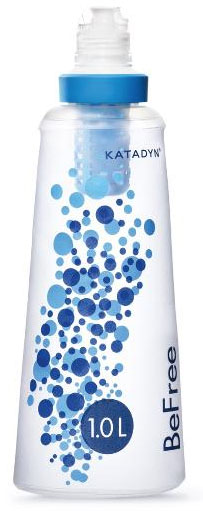 Type: Squeeze filter
Type: Squeeze filter
Weight: 2.3 oz.
Filter life: 1,000 liters
What we like: Extremely light and great for on-the-go hydration.
What we don’t: Short lifespan and doesn't fit standard-sized water bottle openings.
The Katadyn BeFree is one of the most ubiquitous filters in the backcountry, used by everyone from trail runners to day hikers and backpackers. Like the Peak Squeeze above, the combination of screw-on filter and soft flask allows you to drink as you would from any standard water bottle, with the water passing directly through the filter on its way to your mouth. But the BeFree differs in a few ways: Its wider mouth makes refilling easier, and the whole setup is featherlight (just 2.3 oz) and noticeably more compact. The recreational hiking crowd will likely want to stick with the more durable Peak Squeeze, but ultralight enthusiasts (including hikers, climbers, bikepackers, and runners) will be better served with the BeFree.
If the Katadyn BeFree appeals to you, your other option is to purchase the HydraPak Filter Cap above and pair it with a soft flask. In our experience, the HydraPak is the runaway winner in terms of build quality and filter life—we’ve tested both filters extensively and the BeFree’s flow rate (especially after some use) is much slower than that of the HydraPak. And if you’re considering the BeFree for backpacking, you’ll also want to consider the Sawyer Squeeze, which has a longer filter life (a lifetime warranty, in fact), doesn’t clog as quickly, and can convert to an inline or gravity filter. But for a package deal that’s more streamlined than the Peak Squeeze, there’s a lot to like about the BeFree.
See the Katadyn BeFree Water Filtration System 1.0L
.jpg) Type: Chemical purifier
Type: Chemical purifier
Weight: 3 oz. (total for both bottles)
Treatment ratio: 30 gallons per 1 oz. set
What we like: Light, cheap, effective, and won’t break.
What we don’t: The mixing process is annoying, and the drops leave a faint chemical taste.
There are a number of chemical water treatment options for backpackers, and each has its own set of pros and cons. At just 3 ounces and $15, Aquamira is a liquid chlorine dioxide solution that effectively kills protozoa, bacteria, and viruses. To purify your water, mix 7 drops each of Part A and Part B in the included cap, let it sit for five minutes, and add the mixture to 1 liter of water. Then wait 15 minutes before drinking for protection from Giardia, bacteria, and viruses, or four hours to kill Cryptosporidium (that takes a lot of advanced planning). Without a doubt, this system is inexpensive, lightweight, and won’t malfunction like some of the more complicated filters and purifiers on this list.
Our biggest issue with Aquamira drops is the mixing process. It slows you down on the trail, takes some concentration in terms of measuring out the drops, and can bleach your clothing if you’re not careful. Compared to the Katadyn Micropur above, Aquamira is much more of a process, but the good news is that it's cheaper and can treat a variety of different volumes (the Katadyn is a strict 1 tab/L and is difficult to halve), which makes it great for group use. Finally, keep in mind that with any chemical purification system, you get no filtration and therefore will be drinking all of the particles that make their way into your bottle. This generally is fine for clear mountain runoff but is not optimal for those acquiring water from smaller or more stagnant sources.
See the Aquamira Water Treatment
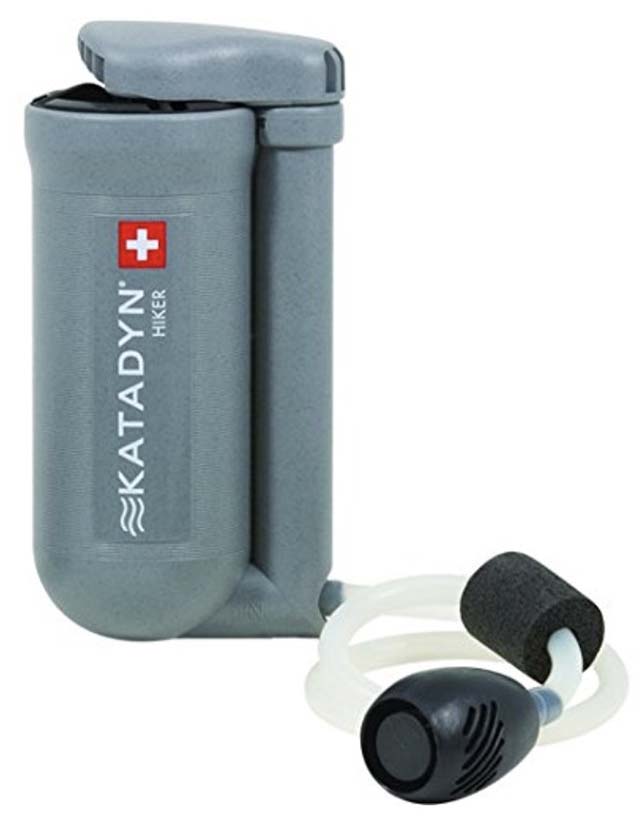 Type: Pump filter
Type: Pump filter
Weight: 11 oz.
Filter life: 750 liters
What we like: A versatile and reliable filter that can make clean water from puddles.
What we don’t: Relatively short filter life and pricey to replace.
Pumping water has its downsides, but we’ve found that the Katadyn Hiker is one of the most reliable filter options across a wide range of backpacking scenarios. Simply put, you break out your Hiker, place the hose end in the water, screw the other end onto your Nalgene (or hold it over top if you have a different type of bottle or reservoir), and pump. You get roughly one liter of clean water per minute if you’re pumping at a good clip, and we’ve found that the Hiker Microfilter works faster and is easier to use than the MSR MiniWorks below. Unlike the MSR Guardian and LifeSaver Wayfarer, however, the Hiker is a filter but not a purifier, so you don’t get virus protection.
In terms of construction, the Katadyn Hiker is well-built for a pump, but these systems are not infallible. The device is made of ABS plastic and has a number of hoses and small parts, and we’ve had pieces snap off of other pumps in the past (not with the Katadyn yet, but it certainly can happen). Another downside is the rather pricey replacement filter: After approximately 750 liters, you’ll need to spend $55 for a new one (the MSR MiniWorks recommends a replacement filter after 2,000 liters and that costs $45). But we still prefer the Katadyn, which despite the shorter filter life, has faster and smoother pumping action.
See the Katadyn Hiker Microfilter
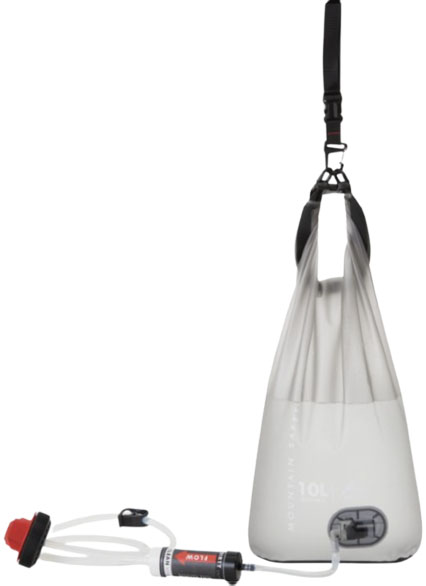 Type: Gravity filter
Type: Gravity filter
Weight: 12 oz.
Filter life: 1,500 liters
What we like: 10 liters of capacity in a relatively lightweight build.
What we don’t: No clean bag; gravity filters have limited applications.
The Platypus Gravity Works is a user-friendly gravity filter with 4 liters of volume, but basecampers and larger groups might want to take a look at the MSR AutoFlow XL here. For $10 less, the AutoFlow can store up to 10 liters of water at a time, which will help you keep your trips to the source to a minimum. At 12 ounces, it’s just a half-ounce heavier than the Gravity Works, and the inline filter passes water at an identical rate (1.75 L/min). What’s more, the MSR comes with an attachment for a wide-mouth Nalgene bottle for easy and leak-free filtering.
The primary downside to MSR’s AutoFlow system is the lack of a “clean” bag. What this means is that you can only fill up your receptacles (hydration bladder, Nalgene, cooking pot, mug, etc.) as fast as the AutoFlow can filter. On the other hand, the Platypus mentioned above filters water into a clean bag and stores it there, making it quickly accessible when you want it. Finally, both systems require a good set-up for effective operation—we prefer to hang our gravity filter from a tree branch, and have thus found it a difficult system to use in alpine environments. All told, if you’re in the market for a high-capacity gravity filter with quality components, the MSR AutoFlow is well worth a second look.
See the MSR AutoFlow XL Gravity Filter
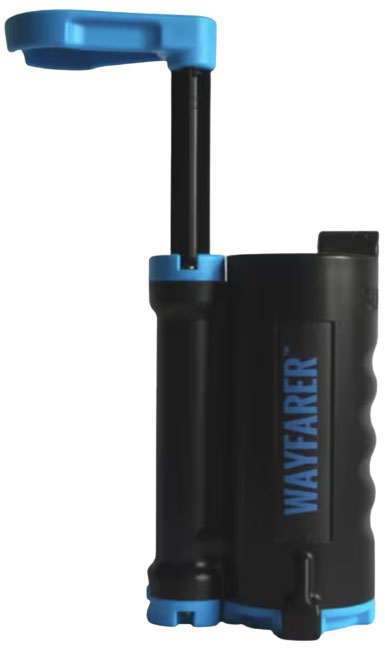 Type: Pump filter/purifier
Type: Pump filter/purifier
Weight: 11.4 oz.
Filter life: 5,000 liters
What we like: A combo filter/purifier for less than a third of the cost of the Guardian above.
What we don’t: Not self-cleaning and replacement filters are hard to come by.
UK-based LifeSaver isn’t a household name in outdoor gear, but their Wayfarer is well deserving of a spot on our list. Like the MSR Guardian above, the Wayfarer is a pump filter that also purifies, ridding your water of debris while also removing protozoa, bacteria, and viruses. In other words, the Wayfarer does it all—and does it all for an impressively low $105. And with a weight of just 11.4 ounces, it’s a lot lighter than the Guardian, too. If the MSR appeals to you but you don’t need such a premium design, LifeSaver’s backcountry offering is well worth a look.
So what do you sacrifice with the Wayfarer’s significantly lower price point? First off, its filter life is half that of the Guardian, and REI unfortunately doesn’t offer replacements (you can purchase them through LifeSaver’s website, but shipping from the UK is an extra $28 at the time of publishing). Second, the Wayfarer is not self-cleaning, which is one of the main features that keeps the Guardian’s flow rate so high throughout its life (the LifeSaver also starts out with a slower flow rate at 1.4L/min). But compared to standard pump filters like the Katadyn Hiker above and MSR MiniWorks EX below, it offers considerably more protection at a similar price point. As our wilderness areas become increasingly crowded a pump filter/purifier starts to make a lot more sense, and the LifeSaver Wayfarer is a very approachable solution.
See the LifeSaver Wayfarer Purifier
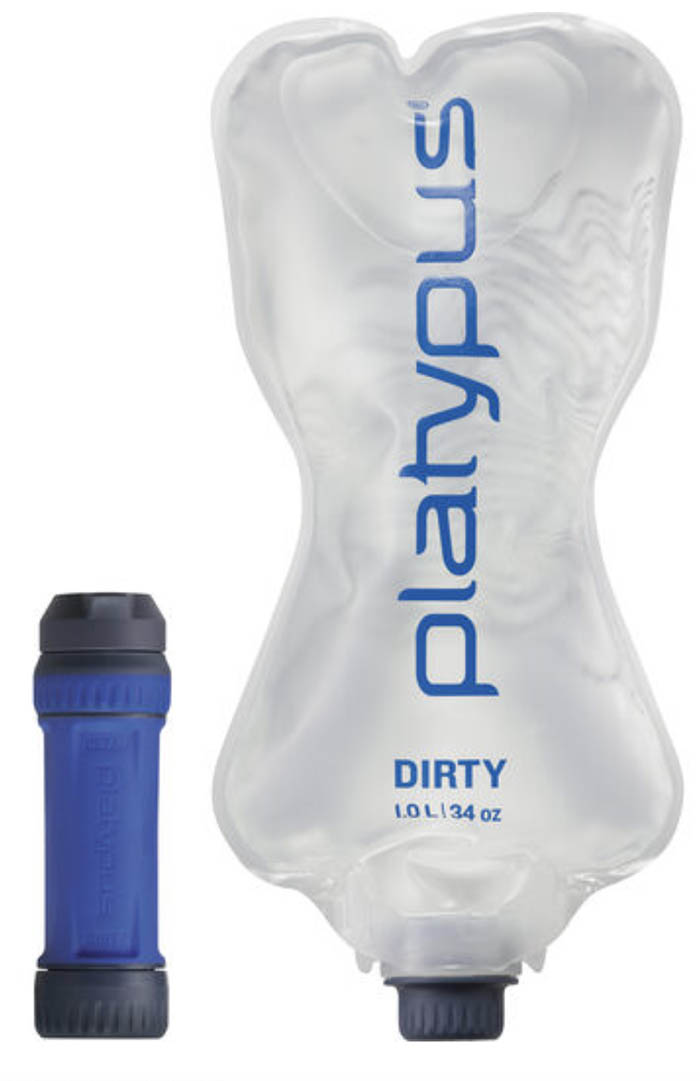 Type: Squeeze filter
Type: Squeeze filter
Weight: 3.3 oz.
Filter life: 1,000 liters
What we like: Fast flow rate; versatile with all 28-millimeter bottle opening.
What we don’t: Short filter life; oblong size is difficult to hold while running.
Platypus’ GravityWorks above is one of our favorite water filters for groups, while their QuickDraw here offers a nice solution for individuals. The QuickDraw is similar to designs like the Sawyer Squeeze and LifeStraw Peak Squeeze above, threading onto a bottle or soft flask with a standard-sized opening (28mm) to filter clean water into your mouth or a separate vessel. The stated flow rate is impressive at 3 liters per minute (compared to the Squeeze’s 1.7 L/min.), and the QuickDraw rolls up into a tight package for storage in your pack or running vest. Importantly, the included Platypus bag is also much more durable than those from Sawyer and even features a convenient handle for easy water retrieval.
We’ve tested both the QuickDraw and Peak Squeeze filters extensively and rank the Platypus below the LifeStraw for a few key reasons. First off, it lacks versatility: While the Peak Squeeze can serve as a nice handheld for trail runners, the QuickDraw’s oblong shape and protruding filter is more difficult to hold. Second, our Platypus reservoir has formed a hole, while the tough LifeStraw soft flask has yet to leak. And finally, the QuickDraw has half the filter life (1,000L vs 2,000L), and ours has begun to clog quickly between cleanings, making for some painfully slow squeezing. But there’s still a lot to like about the Platypus, and it’s about to get better: An updated version is slated to release this spring, which includes an additional cap that seamlessly connects to narrow-mouth bottles and standard-sized hoses.
See the Platypus QuickDraw Microfilter System
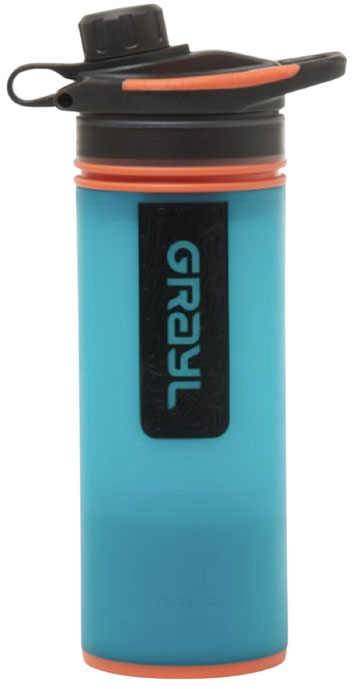 Type: Bottle filter/purifier
Type: Bottle filter/purifier
Weight: 15.9 oz.
Filter life: 65 gallons
What we like: An innovative and easy-to-use purification system.
What we don’t: Not super practical for extended backcountry trips.
The Grayl GeoPress Water Filter and Purifier is a sleek all-in-one solution made with travel and light adventuring in mind. Instead of sticking to the original water-treatment formula—which seems to always require some level of squeezing, pumping, batteries, hoses, or even chemicals—Grayl’s design gets the job done with a simple and eye-catching 24-ounce bottle and plunger. The GeoPress is available in a variety of colors, offers purification on top of filtration, and features a nice drinking spout and cap. What’s more, Grayl also makes the streamlined 16.9-ounce UltraPress ($90) and the UltraPress Ti ($200), which features a durable titanium bottle that can also be used to heat water over a flame.
Though certainly useful for a wide range of scenarios (think traveling in lesser-developed countries or hydrating in camp), the Grayl has limitations. Purifying just 24 ounces (0.7L) at a time, it’s an inefficient system for anything but on-the-go drinking when water sources are consistently available. Additionally, the purifier cartridge has a lifespan of only 65 gallons (or 246L), which pales in comparison to most offerings here (REI offers replacement cartridges for $30). But no other bottle filter beats the Grayl purifier for traveling abroad, and it’s a great alternative to buying water in disposable plastic bottles. For backpacking, the practicality is limited.
See the Grayl 24oz GeoPress Purifier
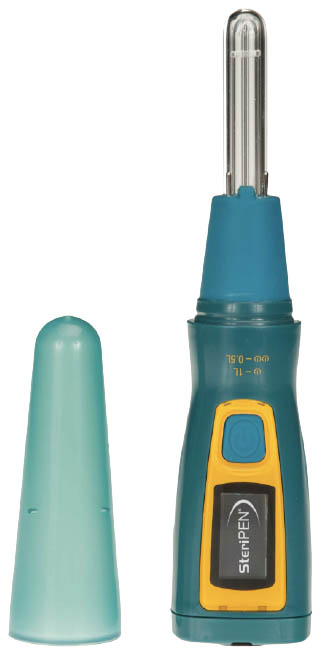 Type: UV purifier
Type: UV purifier
Weight: 4.9 oz.
Lamp life: 8,000 liters
What we like: Lightweight purification without the chemical aftertaste.
What we don’t: Relies on USB charge.
For well over a decade, SteriPen has held a unique place in the water purification market. Instead of the various gravity filters, pumps, and chemical drops on this list, SteriPen’s technology uses UV rays to destroy bacteria, protozoa, and viruses. You simply place the SteriPen in your water bottle or reservoir and swirl until the device indicates you’re finished—it takes about 90 seconds to purify 1 liter. And the Ultra here is our favorite model, with a durable 4.9-ounce build, helpful LED display, and convenient USB-rechargeable Lithium-Ion battery.
We love the concept of the SteriPen but have mixed feelings after extended use. The lack of filtration certainly is a downside and means that unless you don’t mind drinking silt or other particles, you’re limited to moving water sources of a decent depth. Second, the SteriPen uses a USB-rechargeable lithium-ion battery, and if that runs out and you don’t have a portable charger, you’re stuck in the wilderness with no purification. Finally, when using the SteriPen, it’s hard to feel totally confident that it worked—rational or not. Did I submerge the device too little or too much? Is the process really complete? But we’ve never been sick after using a SteriPen, so those concerns haven’t yet been realized. The Ultra UV is out of stock at the time of publishing, but SteriPen also offers their Adventurer Opti UV, which features a rugged design that's powered by two CR123 batteries.
See the SteriPen Ultra UV Water Purifier
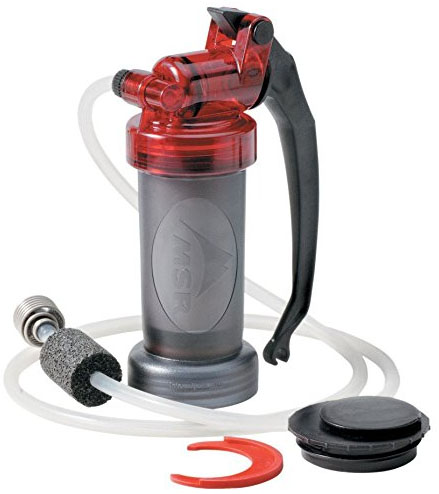 Type: Pump filter
Type: Pump filter
Weight: 16 oz.
Filter life: 2,000 liters
What we like: One of the few pump designs with a ceramic filter.
What we don’t: Heavier and pricier than the Katadyn Hiker.
Despite all of the recent innovations, the MSR MiniWorks remains one of the most popular pumps on the market. Compared to the Katadyn Hiker above, the designs have identical filter pore size (.2 microns) and protect against the same contaminants, including Giardia and Cryptosporidium. But while the Katadyn is $30 cheaper and lighter at 11 ounces, the MSR has a significantly longer filter life at 2,000 liters (the Hiker’s is just 750L), with a carbon/ceramic design that’s easy to clean in the field. All told, it’s a well-built pump from one of the most trusted brands in water filtration.
However, we have the MSR MiniWorks ranked here because of our own in-the-field experiences. We found the pump to be slow from the outset (it has a listed flow rate of 1L/min., but we didn’t experience that). Further, our version became almost unworkable midway through a Utah backpacking trip. The water was rather murky, but that’s no excuse for pump failure just a few days out of the box. User reviews generally are positive and we are looking forward to getting another MiniWorks out for more testing, but regardless, we’ll take the lower weight and cost of the Katadyn.
See the MSR MiniWorks EX Microfilter
 Type: Bottle/straw filter
Type: Bottle/straw filter
Weight: 8.7 oz.
Filter life: 4,000 liters
What we like: Incredibly convenient and relatively long filter life.
What we don’t: Heavier and bulkier than soft-flask bottle filters.
For those wanting a dedicated water bottle filter, the LifeStraw Go has a lot of appeal. Like the soft-sided bottle filters above, the Go makes water treatment as simple as taking a sip, but the hard-sided bottle boosts durability and convenience for casual day hikes and frontcountry applications—no squeezing or cold hands required. Additionally, with a filter life of 4,000 liters, the LifeStraw boasts four times the longevity of the BeFree. All in all, it’s an ideal and long-lasting setup for adventures when weight and bulk aren’t top considerations.
But for all of its convenience, the LifeStraw Go isn’t that versatile—you get a bottle of filtered water, and that’s about it. Because it’s a straw filter, you can’t use the Go to squeeze water into an empty bottle or a pot for cooking (like you might with the BeFree or Sawyer Squeeze). Also, take note that the straw is bulky, which reduces the amount of overall water storage. But for short adventures or those who like to filter their tap water, the LifeStraw Go is one of the most convenient and user-friendly options available.
See the LifeStraw Go 22 Oz.
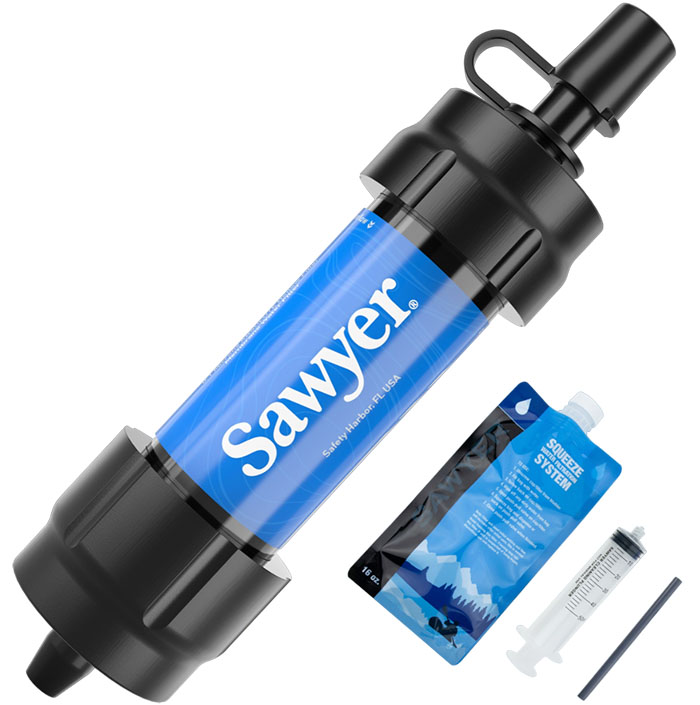 Type: Squeeze filter (inline adaptors available)
Type: Squeeze filter (inline adaptors available)
Weight: 2 oz.
Filter life: 100,000 gallons
What we like: Feathery light.
What we don’t: We’ll stick with the better-performing and longer-lasting Sawyer Squeeze.
One ounce lighter and $16 cheaper than the Sawyer Squeeze above, the Sawyer Mini is one of the lightest and most compact water filters on the market. Like the Squeeze, the Mini attaches to its included bag or other compatible water bottle to squeeze filtered water into your mouth or drinking vessel. You’ll have to purchase inline adapters separately for use with a gravity system or hydration reservoir, but the Mini is nevertheless a decent option for those who don’t mind a simple bottle filter. And while its 100,000-gallon filter life pales in comparison to the standard Squeeze’s lifetime guarantee, it’s still incredibly impressive compared to most options here.
It shouldn’t come as a surprise that the smaller and less expensive Mini is slower to filter and more prone to clogging. We brought the Mini along on a 4-day trek in Patagonia (with clear water sources), and it required so much suction when paired with a smartwater bottle that we resorted to our group’s gravity filter instead. Additionally, the small 16-ounce pouch isn’t ideal for filling up standard water bottles, and we’ve had bad luck with delamination and leaks on all of our Sawyer bags. In the end, we don’t recommend the Mini for anything other than emergency use, especially given that the Squeeze is a fully functional alternative for just 1 ounce and 20 bucks more. And if you want to keep weight down, it’s also worth checking out the Hydroblu Versa Flow filter, which is still lightweight at 2.6 ounces but has a faster flow rate than the Mini.
See the Sawyer Mini Filter
.jpg) Type: Chemical purifier
Type: Chemical purifier
Weight: 3 oz.
Treatment ratio: 0.5 liter per tablet
What we like: Lightweight and cheap.
What we don’t: Tastes funky and takes 30 minutes to activate.
Potable Aqua tabs are a classic and a method that we’ve used as a filter backup for years. The system couldn’t be simpler: put two iodine tablets in a liter of water, wait 30 minutes, and drink. Most importantly, they kill bacteria, protozoa, and viruses, thereby purifying water for drinking. Similar to the Aquamira drops, Katadyn tablets, and SteriPen above, keep in mind that you will be drinking unfiltered water, so Portable Aqua is best used with relatively clean mountain water.
The big downside of Potable Aqua is taste. Neutralizer tablets are available and do a decent job of masking the chemical flavor, and many people add a drink mix to make a tastier concoction. If you’re wondering about the differences between iodine (Potable Aqua) and chlorine dioxide (the Katadyn and Aquamira above), the former is not effective in killing Cryptosporidium, while the latter is categorized by the CDC as having low to moderate effectiveness. Further, the Katadyn and Aquamira don't have as many issues with taste, which is why they land higher spots on our list.
See the Potable Aqua Tablets
| Filter/Purifier | Price | Type | Weight | Flow Rate | Filter Life | Capacities |
|---|---|---|---|---|---|---|
| Platypus GravityWorks 4L | $135 | Gravity filter | 11.5 oz. | 1.75 L/min | 1,500 liters | 2L, 4L, 6L |
| Sawyer Squeeze | $41 | Squeeze/inline filter | 3 oz. | 1.7 L/min | Lifetime | 32 oz. |
| HydraPak 42mm Filter Cap | $35 | Squeeze filter | 2 oz. | 1 L/min | 1,500 liters | Various |
| LifeStraw Peak Squeeze 1L | $44 | Squeeze filter | 3.9 oz. | 3 L/min | 2,000 liters | 0.6L, 1L |
| MSR Guardian | $390 | Pump filter/purifier | 17.3 oz. | 2.5 L/min | 10,000 liters | Unlimited |
| Katadyn Micropur MP1 | $16 | Chemical purifier | 0.9 oz. | 1 L/30 min | 1 liter/tab | Various |
| Katadyn BeFree 1.0L | $45 | Squeeze filter | 2.3 oz. | 2 L/min | 1,000 liters | 0.6L, 1L |
| Aquamira Water Treatment | $15 | Chemical purifier | 3 oz. | 1 L/20 min | 30 gallons/1 oz. | Various |
| Katadyn Hiker | $90 | Pump filter | 11 oz. | 1 L/min | 750 liters | Unlimited |
| MSR AutoFlow XL Gravity | $125 | Gravity filter | 12 oz. | 1.75 L/min | 1,500 liters | 10L |
| LifeSaver Wayfarer Purifier | $105 | Pump filter/purifier | 11.4 oz. | 1.4L/min | 5,000 liters | Unlimited |
| Platypus QuickDraw | $50 | Squeeze filter | 3.3 oz. | 3 L/min | 1,000 liters | 1L |
| Grayl 24oz GeoPress | $100 | Bottle filter/purifier | 15.9 oz. | 5 L/min | 65 gal. (246L) | 24 oz. |
| SteriPen Ultra UV | $130 | UV purifier | 4.9 oz. | 1 L/90 sec | 8,000 liters | 0.5L, 1L |
| MSR MiniWorks EX | $120 | Pump filter | 16 oz. | 1 L/min | 2,000 liters | Unlimited |
| LifeStraw Go 22 Oz. | $45 | Bottle/straw filter | 8.7 oz. | Unavailable | 4,000 liters | 22 oz., 1L |
| Sawyer Mini Filter | $25 | Squeeze filter | 2 oz. | Unavailable | 100,000 gallons | 16 oz. |
| Potable Aqua Tablets | $10 | Chemical purifier | 3 oz. | 1 L/30 min | 0.5 liter/tab | Various |
The words “filter” and “purifier” often are used interchangeably, but knowing the differences between the two is a key step in choosing the best water treatment for your needs. The most important distinction comes in the level of protection each method provides. Water filters use microscopic pores to strain out protozoa (such as Giardia) and bacteria (E. Coli and Salmonella, for example). Water purifiers also remove protozoa and bacteria, but they eliminate viruses as well (like Hepatitis A and the Norovirus). Viruses are rarely found in natural sources, which is why most backcountry-goers find filters to be fully sufficient. However, if you’re traveling in less-developed regions of the world or want to be extra cautious in high-traffic wilderness areas, a purifier is a great option to have.
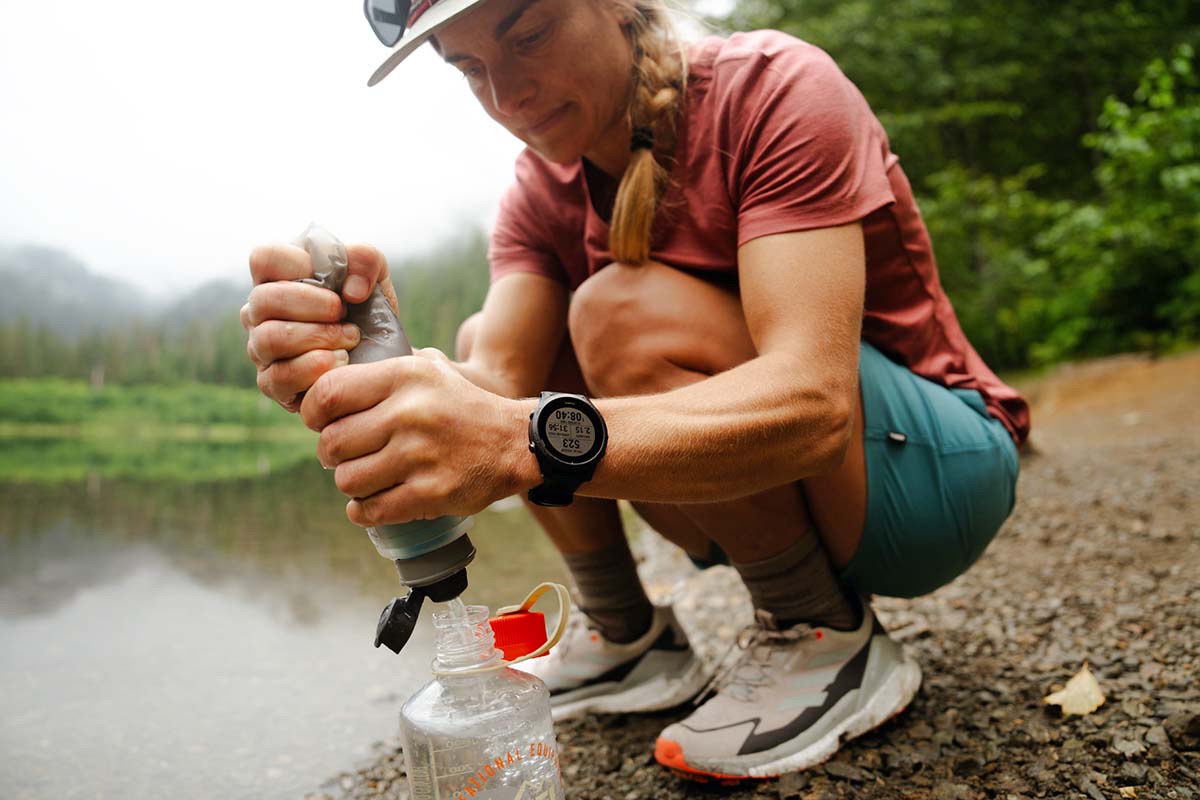
Second, by definition, a filter routes water through an actual sieve, which physically removes debris such as dirt, algae, leaves, and tiny critters. By contrast, most purifiers use chemicals or ultraviolet light to treat water straight from the source (i.e. unfiltered water). This is important to keep in mind if you’re drawing from unclear water sources such as a silty river, murky pond, or muddy desert pool. We’ll usually opt for a filter in these scenarios, but if you’re using a purifier it’s a good idea to pre-filter your water (more on this below). Finally, some premium treatment options both filter and purify water, such as the MSR Guardian or the budget-oriented LifeSaver Wayfarer.
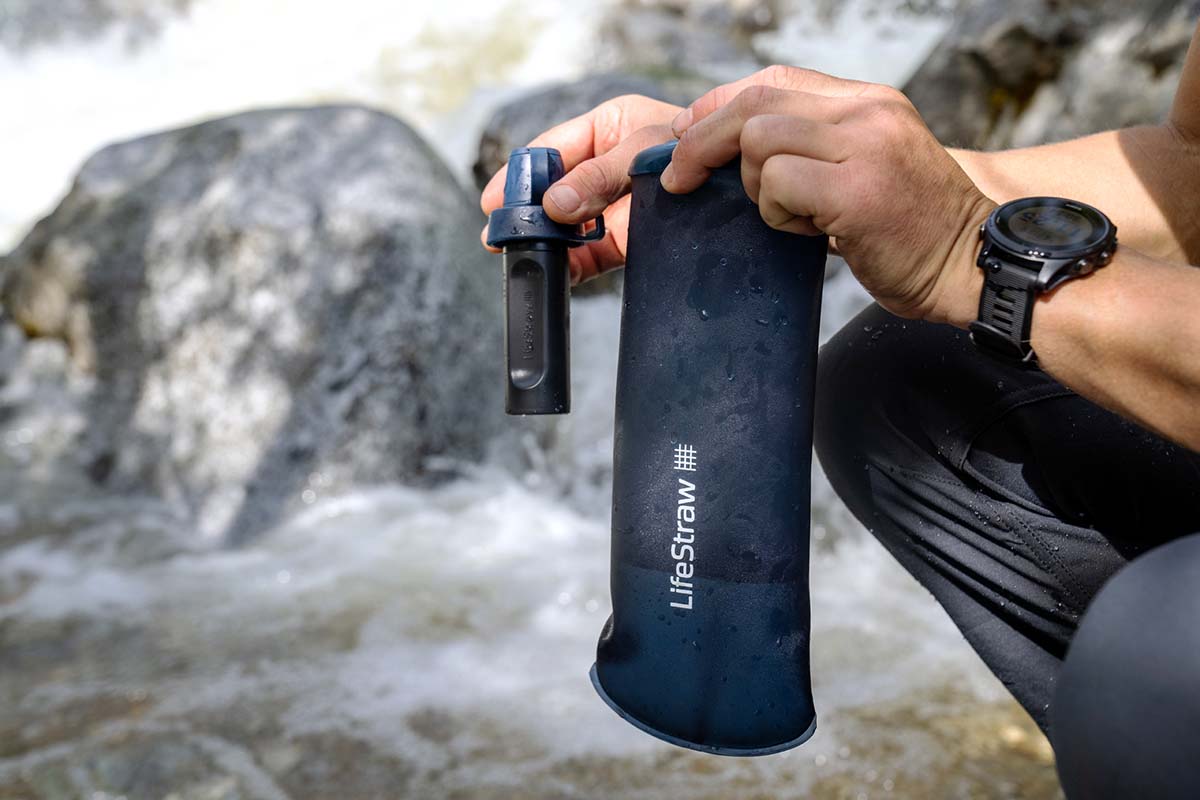
Gravity/Inline Filters
Gravity systems—which use an inline filter—are best for groups, basecamping, or anytime you want to filter large quantities of water with minimal hands-on effort. Simply fill the dirty water bag, hook up the filter to the port or hose, and let gravity do the work. Some gravity systems have a separate “clean” reservoir to collect the water, while others dispense it straight into your vessel (or mouth) via a hose with an on/off valve. But gravity filters aren’t for everyone: they’re bulkier and heavier than most alternatives, and you’ll need a fairly good water supply to fill up your reservoir (pumps are better for shallow sources). Finally, gravity filters aren’t our first choice for on-the-go water treatment, as setting up the system can take some time, and you’ll need somewhere to hang it (something to keep in mind if you're headed above treeline).
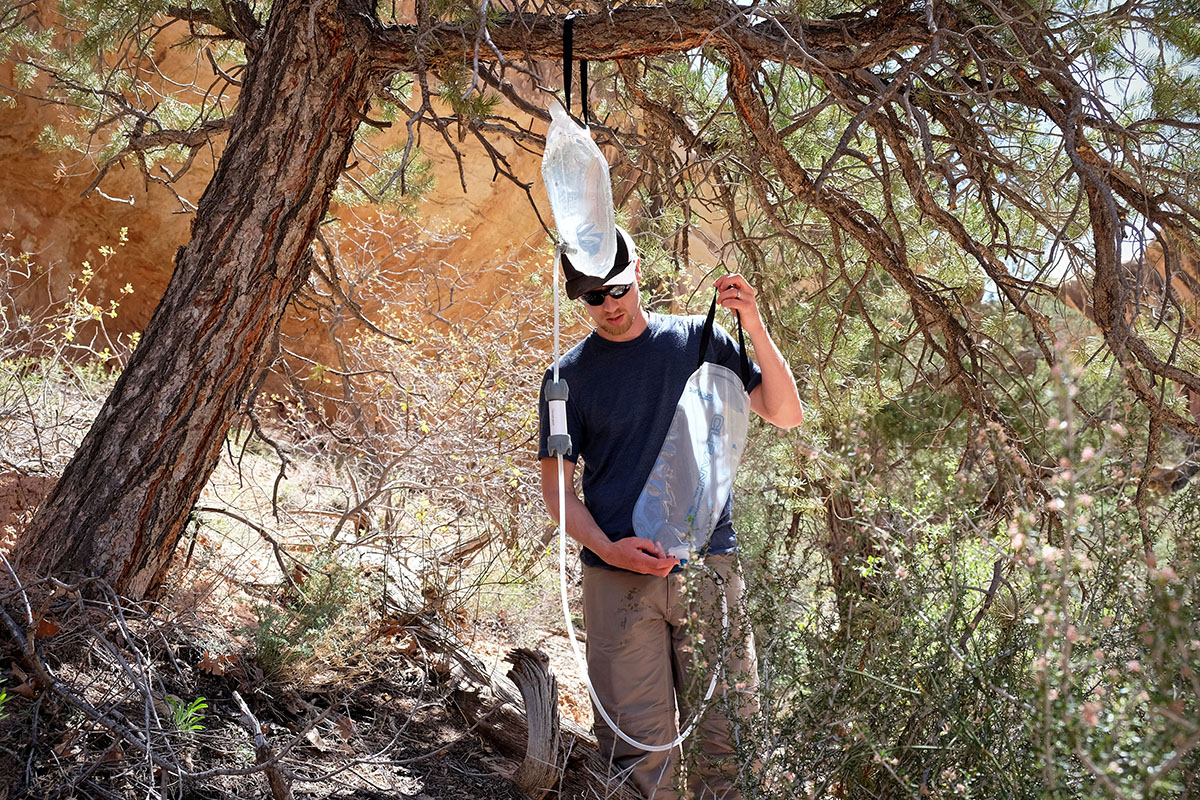
Although they’re most commonly used in gravity setups, inline filters also can be paired with a hydration reservoir (purchased separately) to provide on-the-go filtration for solo travelers. Instead of gravity doing the work, suction brings the water from the “dirty” bag, through the filter, and into the hydration hose to the mouth. Used in this way, an inline filter will only add about 3 ounces to your kit (assuming you’re already bringing a reservoir) and is an efficient way for individuals to stay hydrated, although your setup has to be perfect—we've found that if any component gets pinched or falls into the wrong orientation, the flow of water will stop. For this application, some of our favorite filters are the MSR Thru-Link and HydraPak 28mm Filter Kit, and models like the Sawyer Squeeze quickly convert into an inline filter with included adapters.
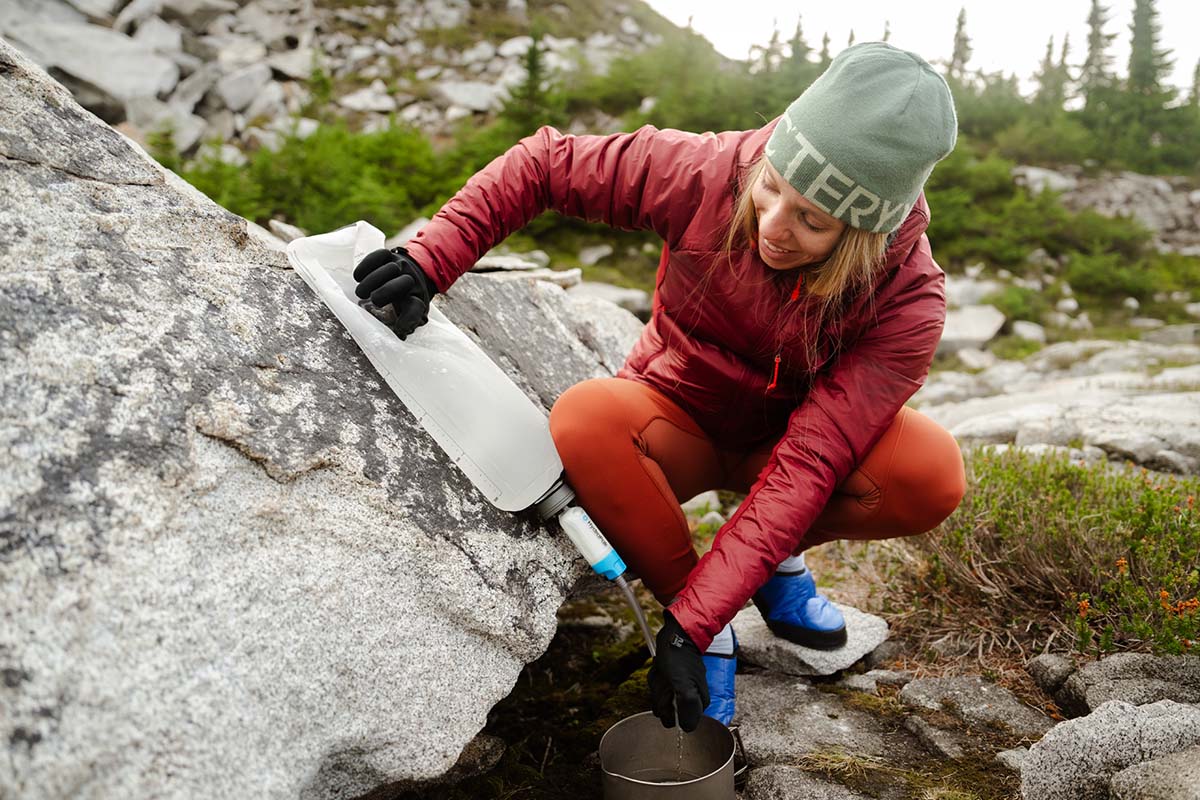
Pump Filters/Purifiers
Pump filters are a great option for small groups (1 to 4 people), and especially when you need to pull water from shallow pools. Using simple mechanics (and some elbow grease), a pump siphons water from the source, through a hose and filter, and out another hose into a clean receptacle. But while they have long been a popular option for backcountry filtration, pump filters recently have been outpaced by other styles. They’re among the heaviest systems, take more time and effort than most methods, and cleaning the cartridges isn’t as easy as a simple backflush (as with most inline and straw filters). That said, for those who enjoy the process of camp chores and don’t mind a little gear maintenance, we certainly understand the appeal.
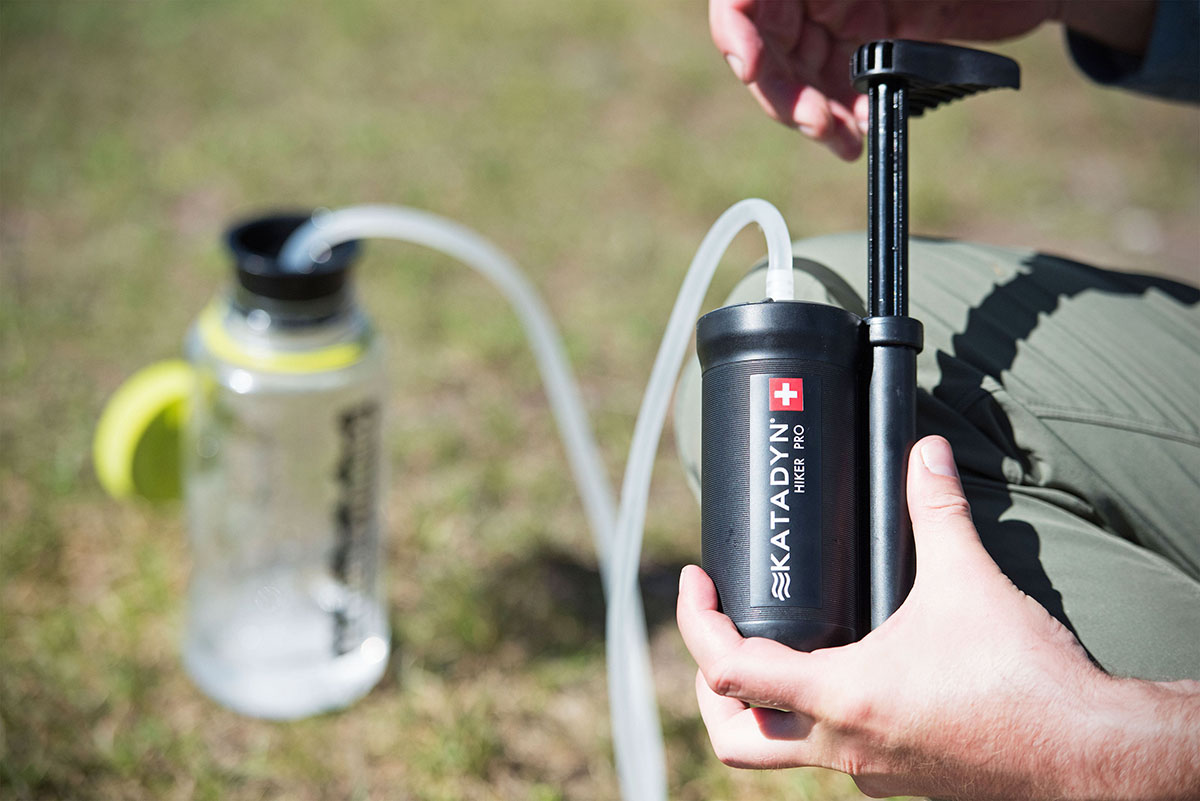
Squeeze Filters
Squeeze filters attach to the spout of a soft-sided bottle or pouch and filter water as you drink. Their lightweight and easy-to-use design makes them a great option for weight-conscious trips and solo backpackers, day hikers, trail runners, cyclists, and more. We love these filters for their versatility—in addition to drinking from the bottle or pouch, you can also squeeze water into a separate receptacle for storage. Some designs, including the Katadyn BeFree and HydraPak 42mm Filter Cap, are compatible with the wide-mouth soft flasks included in most running vests. And finally, many squeeze filters (like the Sawyer Squeeze or LifeStraw Peak Squeeze) also can perform as inline or gravity filters, or be used as straws to suction water directly from the source. Keep in mind that squeeze filters are often slower at filtering than a high-performing pump design and require quite a bit more effort than a gravity model. And with particularly cold water, your hands can get pretty chilly, too.
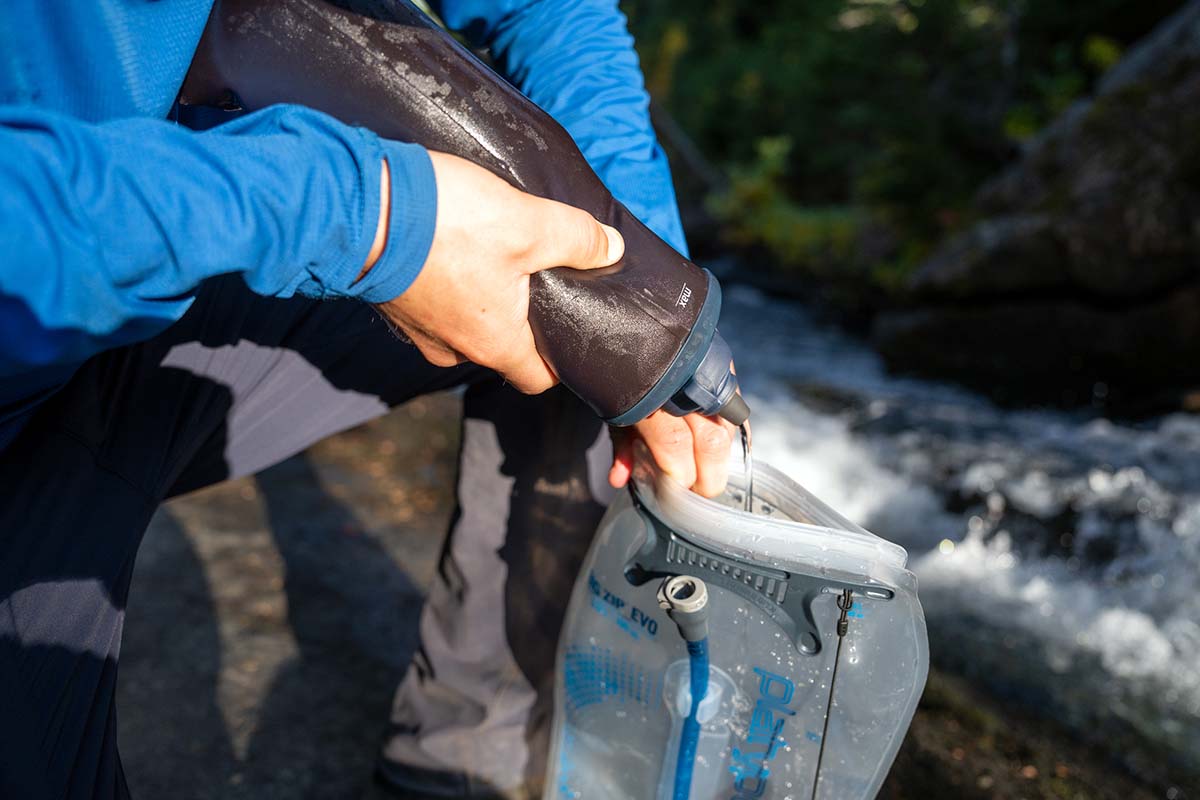
Straw Filters
Used by day hikers, trail runners, and mountain bikers who prefer not to carry water as they move, a straw filter allows you to drink directly from the source, as though sipping through a straw (some setups also include a bottle, like the LifeStraw Go). Straw filters have their place for simple applications and day trips, but are not a very versatile setup as they offer no way to produce or store clean water for cooking or drinking later. Further, some squeeze and inline filters also can be used as a straw (such as the Sawyer Squeeze Mini), and are by far the more well-rounded choice. In general, we don’t recommend simple straw filters for high-performance backcountry use, but they can serve as an emergency backup or novel recreational option.
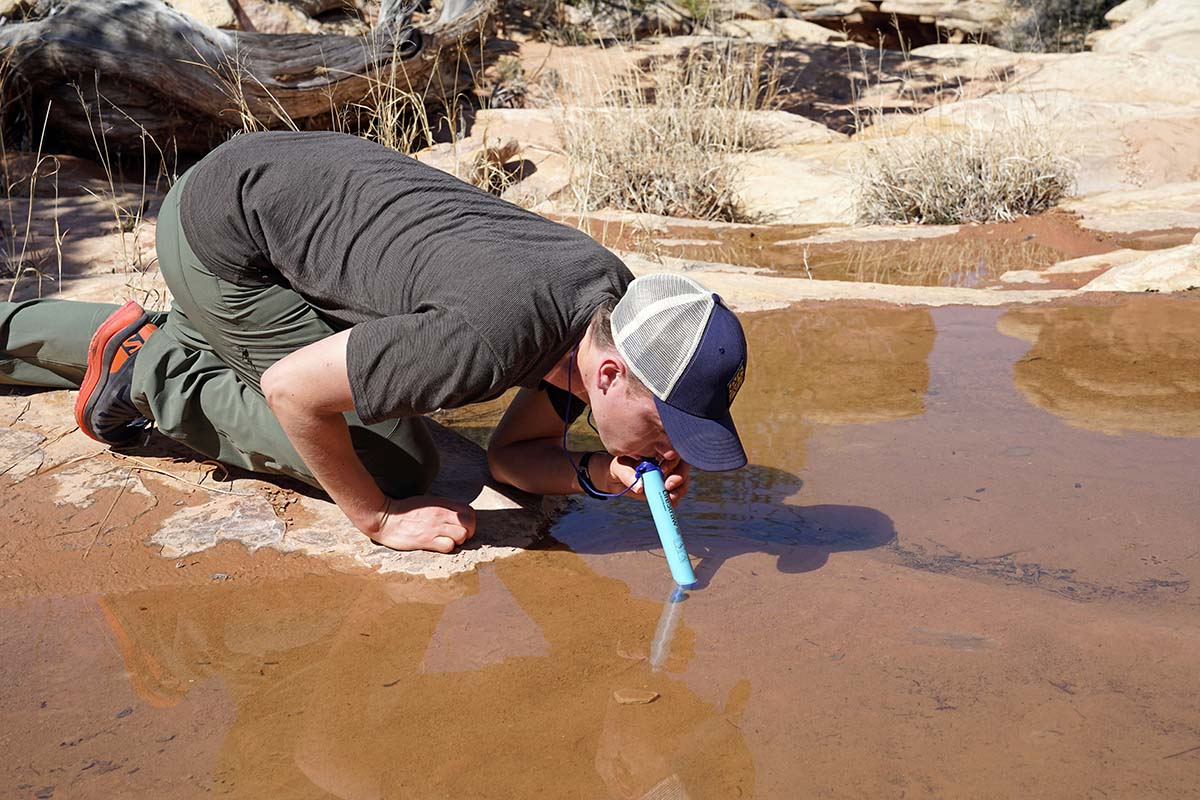
Chemical/UV Purifiers
Available in both liquid and tablet forms, chemical purifiers use iodine or chlorine dioxide to remove protozoa, bacteria, and viruses from water. UV purifiers like the SteriPen use ultraviolet rays to achieve the same effect. The upsides to both methods are clear: they’re relatively lightweight, don’t require the arduous task of pumping or squeezing, and you get protection against viruses, too (filters only remove bacteria and protozoa). But keep in mind that both chemical and UV purifiers forgo filtering, making them good options only when you have access to clear water sources like glacial streams. In addition, chemical purifiers can add an undesirable taste to your water, and UV purifiers require batteries and electronics, which aren’t great to rely on in the backcountry. That said, these purifiers offer a nice alternative to bulkier filters, and we especially like chemical options like Aquamira and Potable Aqua for large groups, weight-conscious outings, or as a backup to a filter.
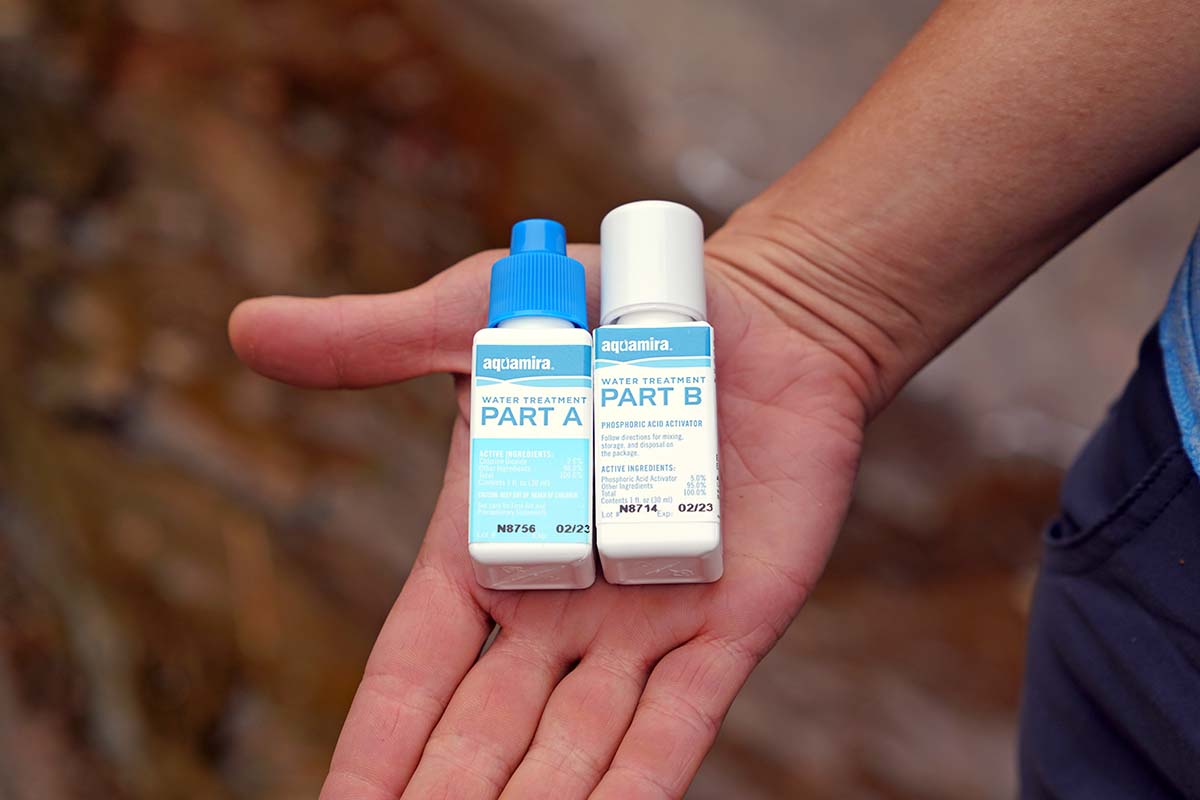
Water filters and purifiers range in weight and bulk, from super lightweight tablets that are just a fraction of an ounce, to the 1-pound 1-ounce MSR Guardian. Most of today’s most popular options for individuals settle in the 2 to 5-ounce range. As with all backpacking gear, you’ll want to go as light as possible without sacrificing too much in the way of functionality. In general, chemical purifiers are the most minimalist option (and great for groups), with squeeze filters like the 2-ounce Sawyer Squeeze Mini not too far behind (although they’re slightly larger in size). Pumps and gravity systems are the heaviest and bulkiest, and include multiple components like storage bags and hoses. Finally, keep in mind that when calculating the weight of your setup, that you’ll also want to factor in your water storage (bottle, reservoir, etc.).
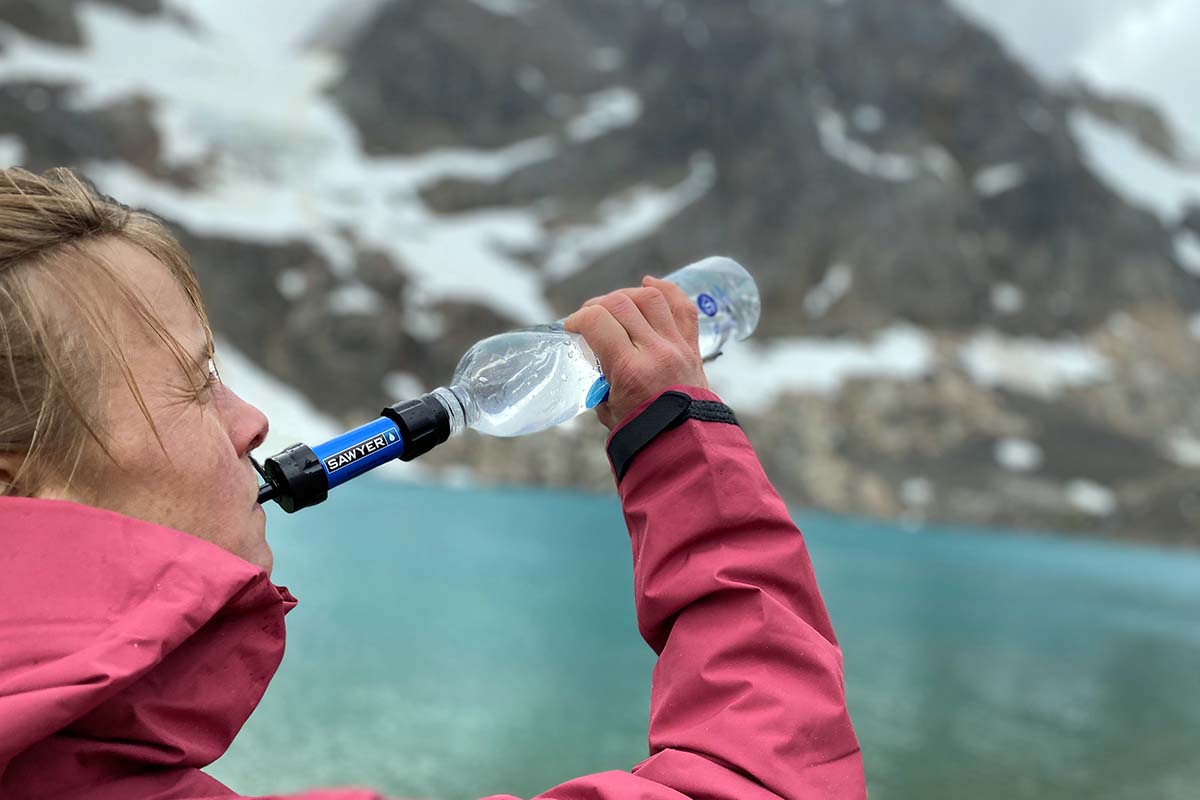
Pore size refers to the size of the tiny openings in the filter, and is measured in terms of microns. The smaller the pore, the more particles the filter can block. According to the CDC guide on water treatment, a pore size of 1 micron (or less) is needed to filter out protozoa, while you’ll need a pore size as small as 0.3 micron to filter out bacteria. Viruses, on the other hand, can be as small as 0.02 micron. Most backpacking filters on this list have a pore size of 0.1 or 0.2 micron, which is why they sift out protozoa and bacteria, but not viruses. Because they are so small, the best way to combat viruses is through chemical or ultraviolet purification. Alternatively, the MSR Guardian pump purifier uses 0.02-mircon hollow fibers to filter viruses.
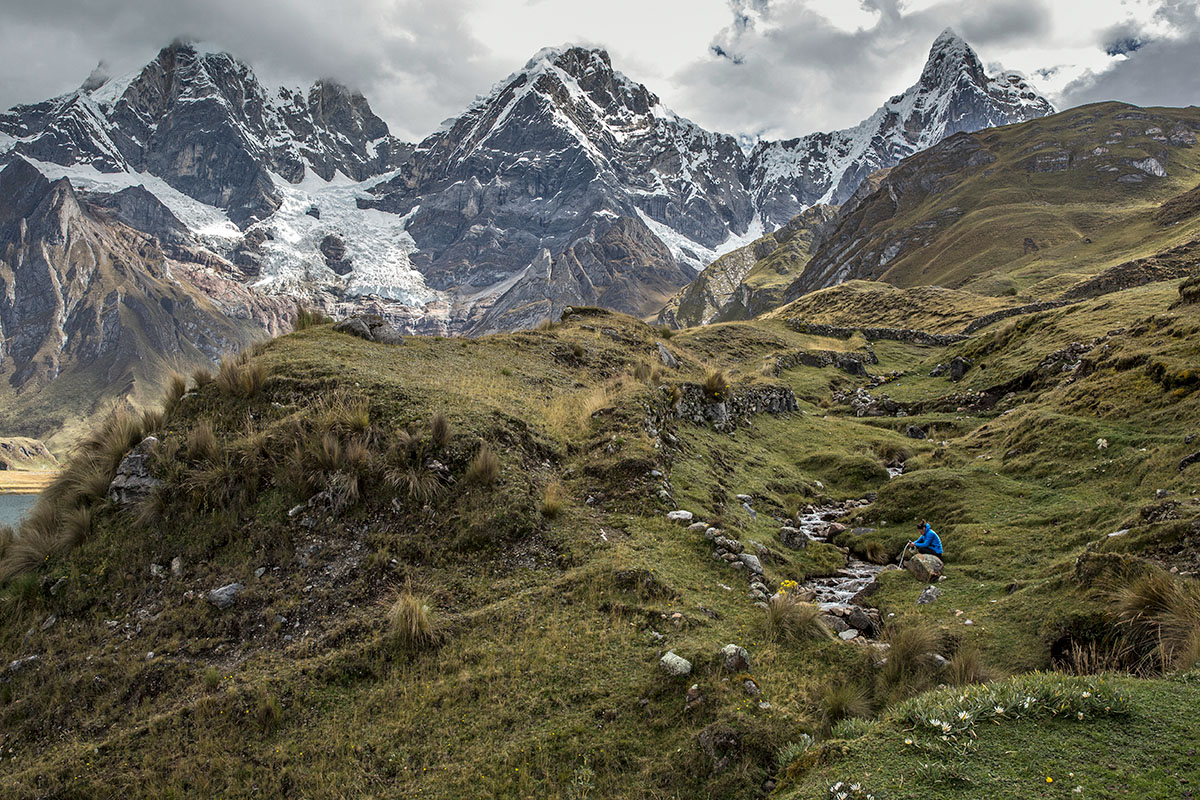
The flow rate indicates the speed at which a filter treats water, and is most often measured in terms of liters per minute. In general, gravity filters have the fastest flow rates: The Platypus GravityWorks filters 1.75 liters per minute, which means it only takes a few minutes to fill a 4-liter bladder with clean water. Leading pump filters are listed at about 1 liter per minute, although that seems fairly optimistic to us (the exception is the pricey MSR Guardian, which is speedy at 2.5 L/min.). Finally, squeeze and straw filters can only move as fast as you can drink or squeeze, although newer models like the Platypus QuickDraw and LifeStraw Peak Squeeze advertise rates of up to 3 liters per minute. Keep in mind that the flow rates listed by the manufacturers are going to be realized in optimal circumstances (i.e. clear water), and you'll need to stay on top of filter maintenance to keep things moving properly (more on this below).
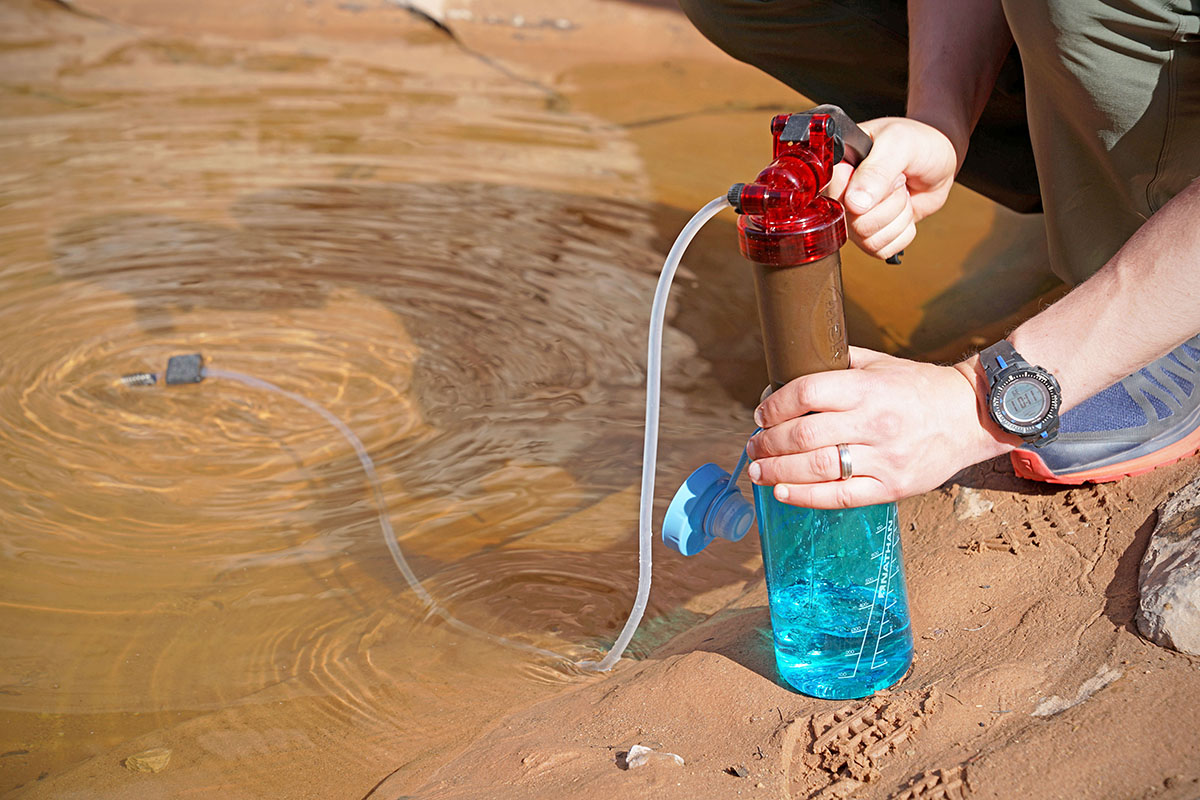
Because chemical and ultraviolet purifiers do not filter water, they don’t have a flow rate. However, they do have a wait time that must lapse before water is safe to drink, usually between 15 and 30 minutes (and sometimes a full 4 hours for Cryptosporidium) for chemical purifiers, and 90 seconds per liter for a SteriPen. The good news about chemical purifiers is that you can sit back and let them do their work, rather than pumping or squeezing as in the case of some filters. All told, flow rate will be an important consideration for groups and time-conscious endeavors, but less of an issue for more casual hikers and backpackers.
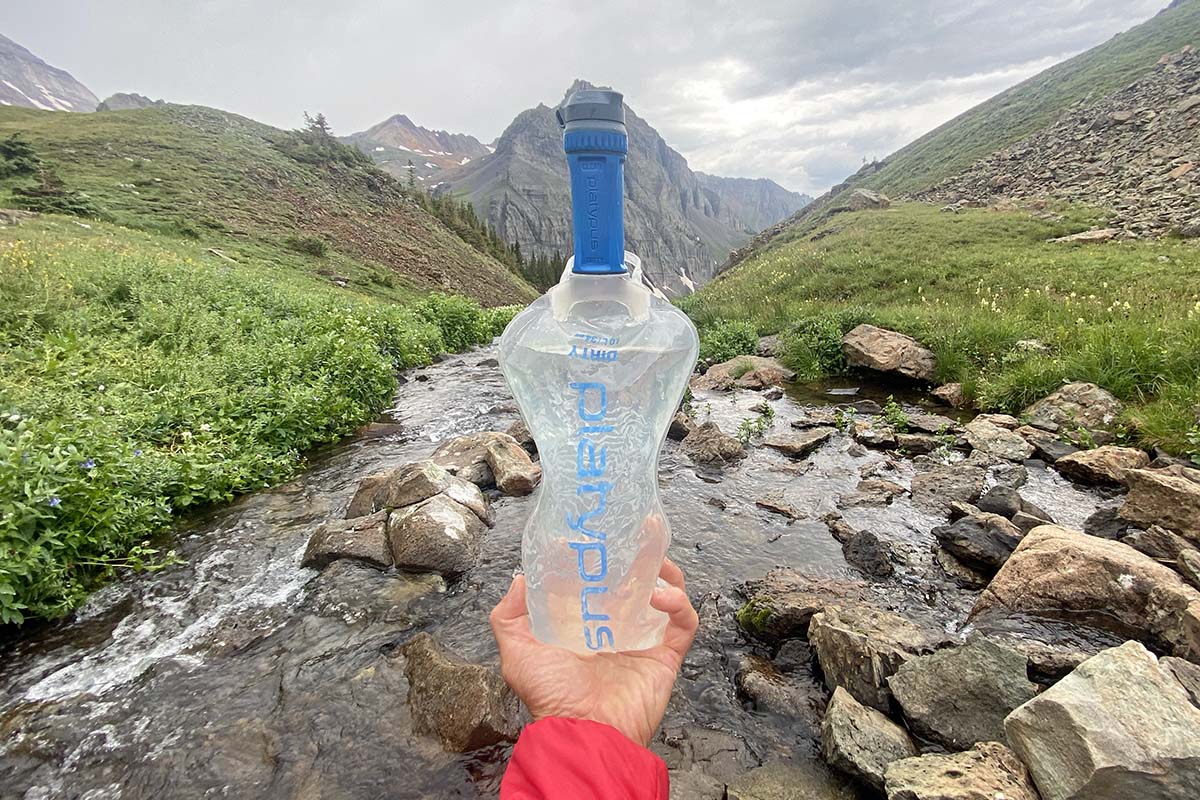
A key product specification that we reference in this article is filter life, or how quickly your filter will need to be replaced. The primary consideration here is cost: You have the initial purchase price of the item, but after a certain number of liters of water have been filtered, you’ll need to buy a replacement cartridge. For example, two of our favorite pump filters are the Katadyn Hiker and MSR MiniWorks. The purchase price of the Katadyn is $40 less than the MSR, but it has a shorter filter life of 750 liters vs. 2,000 liters, which is a big difference. Given that the Katadyn replacement filter costs $55 vs. $45 for the MSR, this brings the cost of the system up over a period of years. On the extreme ends of the spectrum, the Grayl GeoPress has a cartridge life of only 65 gallons, while the Sawyer Squeeze has a lifetime warranty—they don’t even make replacement cartridges for it.
.jpg)
As with any manufacturer-provided spec, the listed filter life is optimistic and probably should be thought of as a maximum. Furthermore, many of these filters and purifiers are made with a great deal of plastic and it’s fairly likely that you’ll break another component of the device before the filter expires. Finally, keep in mind that the 750 liters referenced above for the Katadyn is actually a lot for most casual backpackers that get out a few times a year. If your filter lasts that long and you’re ready for a new cartridge, then you’ve gotten a lot of use and clean water out of it, making it a solid investment.
Given that their task is to remove contaminants from water, it should come as no surprise that many water filters need to be cleaned of this buildup. Most gravity and straw filters are maintained by backflushing clean water or air through the filter. With a product like the LifeStraw, this is as easy as blowing out after each use. Others require a separate piece of equipment, including the syringe that comes with the Sawyer Squeeze. In general, it’s important to read about and practice maintaining your filter at home before taking it out into the field.
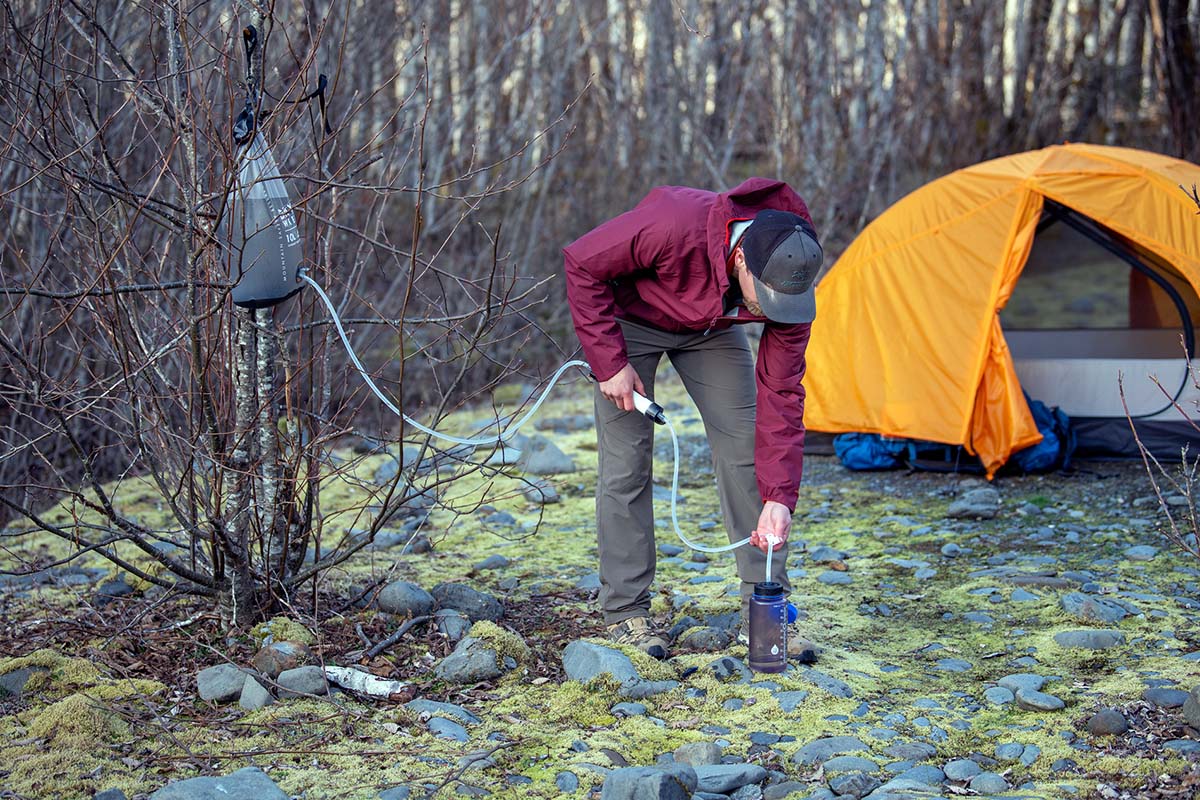
Cleaning pump filters is a slightly more intensive process, as you'll need to unscrew the apparatus and either remove the filter or extend a brush down the interior. Instructional videos are available online for almost every product on our list, and you should expect basic maintenance to be part of owning and using a water filter. If you’re not keen on keeping up your equipment, you can always opt for more carefree models like the SteriPen or chemical treatments like Aquamira or Potable Aqua.
As we touched on above, if you’re not using a dedicated filter to separate out sediment and other particulates, finding a clean and moving water source is the best way to ensure your water tastes good. But should you find yourself with no other option, we’ve found a bandana (or other piece of clothing) to be the most effective pre-filtering method for straining out leaves, sand, and other bits before purification. Another option is to scoop the dirty water into a Ziploc bag, let the sediment settle, and transfer the clear water from the top into a bottle for treatment. With especially dirty water sources, pre-filtering can be a great idea even if you’re using a filter to treat your water, as it will mitigate potential clogging.
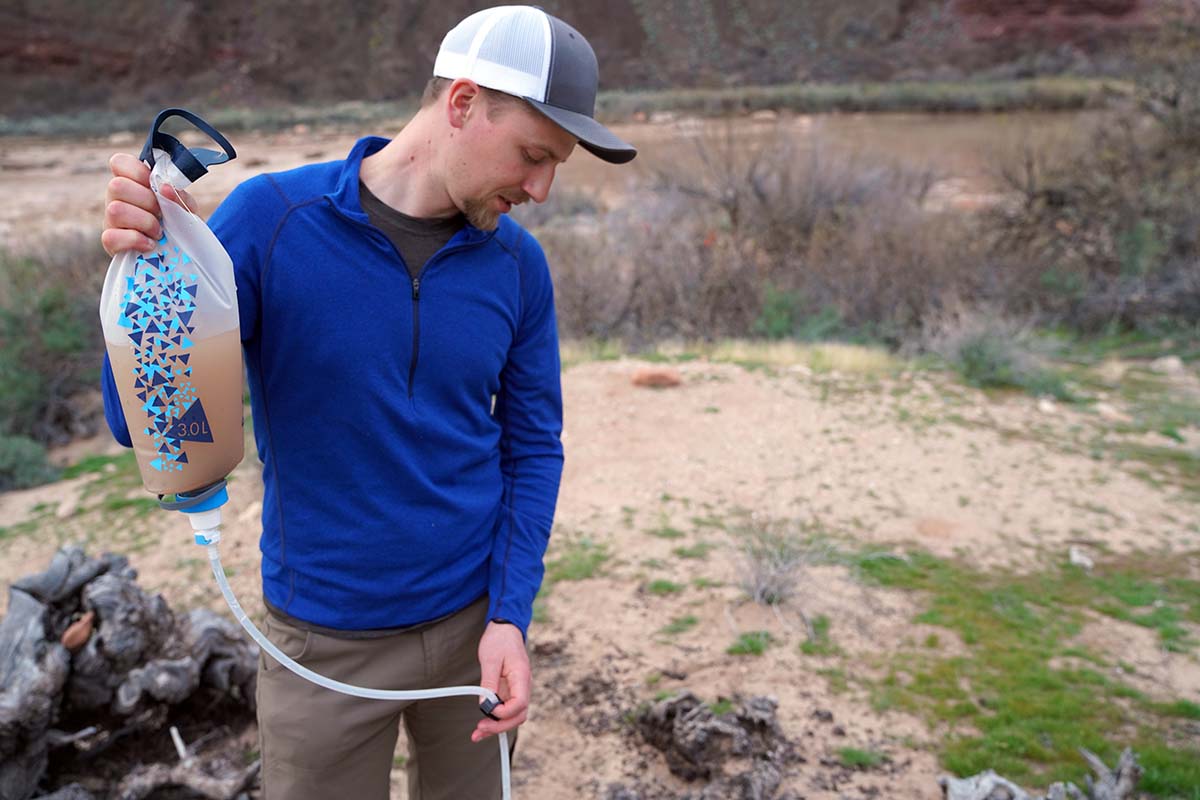
Almost all water treatment systems have some way of connecting to either a water bottle or hydration reservoir, if not both. This often takes the form of a simple hose or cap that fits onto commonly sized openings. The HydraPak 28mm Filter Kit, for example, has a quick-release adapter that attaches directly to your water reservoir, and pump filters like the Katadyn Hiker and the MSR MiniWorks fit the mouth of a standard Nalgene bottle. Sawyer has played into the fast-and-light community of hikers who use disposable plastic water bottles on the trail, making their Squeeze and Mini versions able to screw into the mouth of a standard plastic water bottle (great for weight savings, less great for the environment). On the other hand, the Katadyn BeFree and HydraPak 42mm Filter Cap are only compatible with specific HydraPak soft flasks. All in all, be mindful of the compatibility for a water filter or purifier to make sure it works with your drinking vessels.
Many water filters and purifiers are able to remove bacteria, protozoa, and sometimes even viruses, but they won’t necessarily change the taste of the water. This isn’t a huge issue when you’re drinking straight from cold mountain streams, but it definitely can be as the quality of your water source deteriorates. If you’re using chemicals to purify your water or drinking from questionable sources—perhaps water with floating leaves or plants growing underneath the surface—taste can come into play in a big way. Remember, this doesn’t mean your water isn’t safe to drink—you’ve filtered or purified it—but you can always add an electrolyte-enhanced drink mix like Nuun Sport hydration tablets to make it more palatable (or in the case of Potable Aqua, use the accompanying neutralizing tablets).
Another way to combat foul-tasting water is to use a carbon filter. Used in the popular Brita kitchen filters, carbon removes chlorine, organic compounds, and other bad odor and taste-inducing materials. Not all portable backcountry filters use carbon, but many on our list do including the MSR MiniWorks and Grayl GeoPress. Additionally, some models offer carbon filters as add-ons: The Platypus GravityWorks, for example, sells a carbon element separately that can be added to the existing filter. It’s important to note that carbon becomes ineffective before the filter (after approximately 6 months or 200L), so if this is a feature you want to maintain, choose a filter that allows you to purchase the carbon element separately from the complete cartridge.
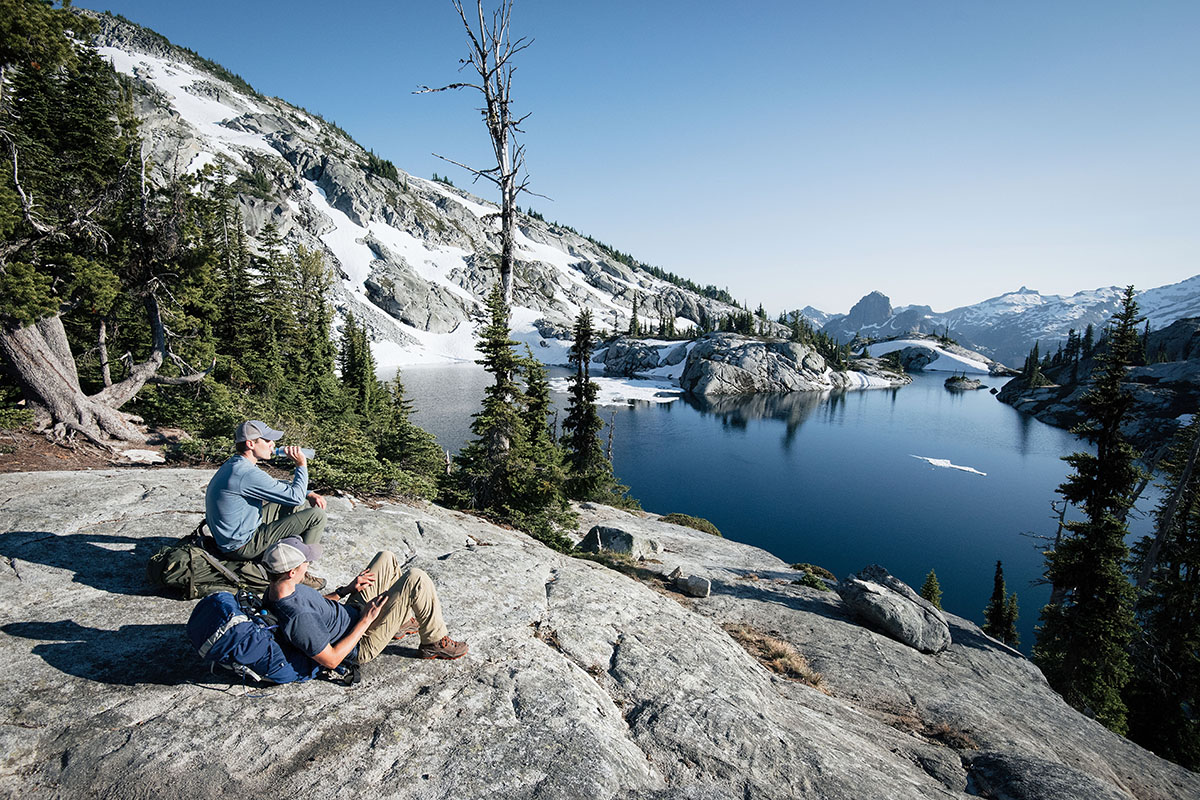
Last but not least, we should mention that just about every water filter and purifier can malfunction, which may leave you without clean water in the backcountry. In this scenario, you can boil your drinking water provided you have a backpacking stove and extra fuel, but this a time and labor-intensive method. For this reason, we think it’s a good idea to carry a lightweight chemical treatment or basic LifeStraw as an emergency backup. The LifeStraw weighs only 2 ounces and costs $20, and Aquamira drops are just $15 for enough solution to treat 30 gallons of water (and a mere 3 extra ounce in your backpack). Getting sick in the backcountry can be a serious medical concern, so we think having a backup is a smart way to go.
Back to Our Top Water Filter Picks Back to Our Water Filter Comparison Table